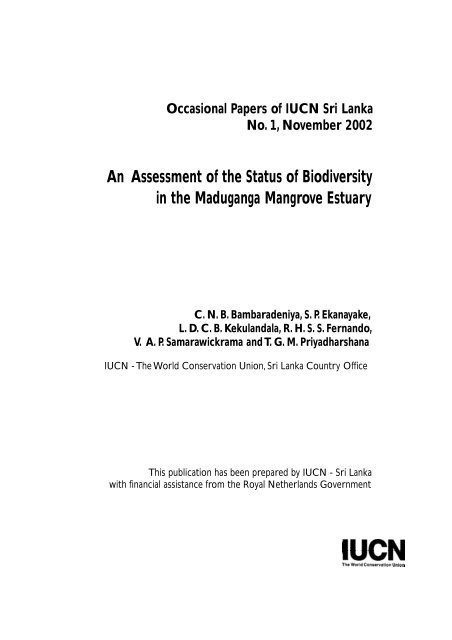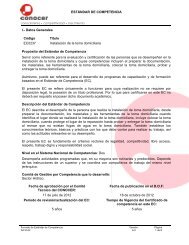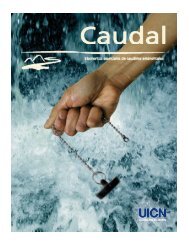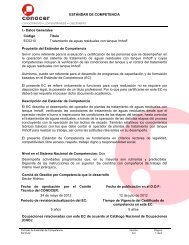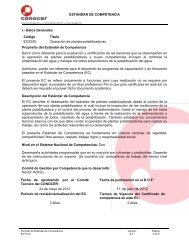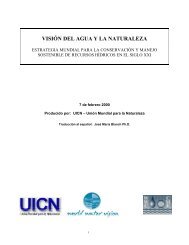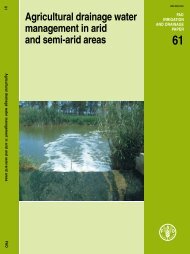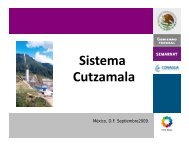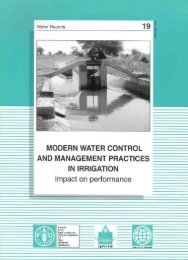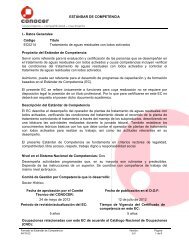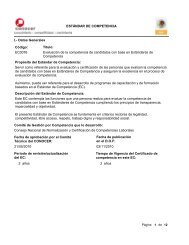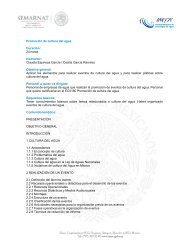An Assessment of the Status of Biodiversity in the ... - IUCN
An Assessment of the Status of Biodiversity in the ... - IUCN
An Assessment of the Status of Biodiversity in the ... - IUCN
You also want an ePaper? Increase the reach of your titles
YUMPU automatically turns print PDFs into web optimized ePapers that Google loves.
Occasional Papers <strong>of</strong> <strong>IUCN</strong> Sri LankaNo. 1, November 2002<strong>An</strong> Asses sment o f <strong>the</strong> <strong>Status</strong> o f Biodiversi ty<strong>in</strong> <strong>the</strong> Maduga nga Mangrove Estua r yC. N. B. Bambaradeniya, S. P. Ekanayake,L. D. C. B. Kekulandala, R. H. S. S. Fernando,V. A. P. Samarawickrama and T. G. M. Priyadharshana<strong>IUCN</strong> - The World Conser vation Union, Sri Lanka Countr y OfficeThis publication ha s been prepared by <strong>IUCN</strong> - Sri Lankawit h f<strong>in</strong>a ncial assist ance from <strong>the</strong> Royal Ne<strong>the</strong>rlands Governmenti
ContentsSummary 11. Introduction 22. Methodology 43. Flora <strong>of</strong> Maduganga 84. Fauna <strong>of</strong> Maduganga 115. Ecological Zon<strong>in</strong>g <strong>of</strong> Maduganga 146. Major Threats to <strong>Biodiversity</strong> <strong>in</strong> Maduganga 157. Recommendations for Conservation <strong>of</strong> Maduganga 198. Acknowledgements 219. Appendices 22I. List <strong>of</strong> flora recorded <strong>in</strong> Maduganga, <strong>the</strong>ir status 22and life formsII. List <strong>of</strong> Plant species observed <strong>in</strong> home gardens 30<strong>in</strong> MadugangaIII. List <strong>of</strong> fish recorded <strong>in</strong> Maduganga 34IV. List <strong>of</strong> amphibians recorded <strong>in</strong> Maduganga 37V. List <strong>of</strong> reptiles recorded <strong>in</strong> Maduganga 38VI. List <strong>of</strong> avifauna recorded <strong>in</strong> Maduganga 39VII. List <strong>of</strong> mammals recorded <strong>in</strong> Maduganga 43VIII. List <strong>of</strong> butterflies recorded <strong>in</strong> Maduganga 44IX. List <strong>of</strong> aquatic molluscs recorded <strong>in</strong> Maduganga 46X. List <strong>of</strong> terrestrial molluscs recorded <strong>in</strong> Maduganga 4710. Literature cited 48iii
SummaryThe Maduganga estuary and mangrove islets are a complex coastal wetland ecosystem situated<strong>in</strong> <strong>the</strong> Galle District <strong>of</strong> Sou<strong>the</strong>rn Sri Lanka. The total area <strong>of</strong> <strong>the</strong> estuary is 915 ha, <strong>of</strong> which770 ha consist <strong>of</strong> open water, while islands account for 145 ha. With <strong>the</strong> view <strong>of</strong> safeguard<strong>in</strong>g<strong>the</strong> ecological functions, resources and values <strong>of</strong> <strong>the</strong> Madu ganga estuary for conservation andfuture sustenance <strong>of</strong> biodiversity, <strong>IUCN</strong> Sri Lanka carried out a systematic assessment <strong>of</strong>biodiversity dur<strong>in</strong>g a six-month period, from May to October 2000. Field monitor<strong>in</strong>g <strong>of</strong> faunaand flora was carried out at fortnightly <strong>in</strong>tervals, <strong>in</strong> a systematic manner, us<strong>in</strong>g scientificallyaccepted biodiversity assessment techniques. A zon<strong>in</strong>g exercise was carried out accord<strong>in</strong>g toecological significance and threats to biodiversity, us<strong>in</strong>g appropriate <strong>in</strong>dicators.The survey revealed that <strong>the</strong> Maduganga wetland consists <strong>of</strong> 10 major wetland vegetationtypes. These vegetation types harboured a total <strong>of</strong> 303 species <strong>of</strong> plants belong<strong>in</strong>g to 95families. The total plant species <strong>in</strong>cluded 19 endemics, 8 nationally threatened species and 9<strong>in</strong>vasive alien species. Based on <strong>the</strong> extent <strong>of</strong> occurrence (ha), mangroves and mangrove mixedswamps were <strong>the</strong> dom<strong>in</strong>ant wetland vegetation types <strong>in</strong> Maduganga. In addition to <strong>the</strong>sewetland vegetation types, three major terrestrial vegetation types are also found <strong>in</strong> <strong>the</strong> islandsand <strong>the</strong> surround<strong>in</strong>g ma<strong>in</strong>land area <strong>of</strong> <strong>the</strong> Maduganga estuary. Perennial crops (ma<strong>in</strong>lyc<strong>in</strong>namon) dom<strong>in</strong>ated <strong>the</strong> terrestrial vegetation types. A total <strong>of</strong> 98 plant species were recordedfrom <strong>the</strong> multi-species home gardens. When consider<strong>in</strong>g <strong>the</strong> species richness <strong>of</strong> flora <strong>in</strong>different wetland vegetation types, mangroves harboured <strong>the</strong> highest number <strong>of</strong> species,closely followed by mangrove mixed swamps. Maduganga estuary harbours a small population<strong>of</strong> a very rare, threatened mangrove species - Lumnitzera littorea. A total <strong>of</strong> 248 species <strong>of</strong>vertebrate fauna, belong<strong>in</strong>g to 121 families were recorded from Maduganga. These <strong>in</strong>cluded20 species (8 %) <strong>of</strong> endemics, while 30 species (12 %) are nationally threatened. The nativevertebrate fauna <strong>of</strong> Maduganga represents 30% <strong>of</strong> Sri Lanka’s native <strong>in</strong>land vertebrate species.Maduganga, perhaps one <strong>of</strong> <strong>the</strong> last rema<strong>in</strong><strong>in</strong>g tracts <strong>of</strong> prist<strong>in</strong>e mangrove forest <strong>in</strong> Sri Lankawith a rich biodiversity, now appears to be threatened with <strong>the</strong> same predicament that many <strong>of</strong><strong>the</strong> island’s mangroves now f<strong>in</strong>d <strong>the</strong>mselves <strong>in</strong>, ow<strong>in</strong>g to <strong>in</strong>creas<strong>in</strong>g human activity. At present,this wetland is not a protected area under any Government Department. Therefore, it isenvisaged that <strong>the</strong> f<strong>in</strong>d<strong>in</strong>gs <strong>of</strong> this survey will contribute to <strong>the</strong> conservation <strong>of</strong> this uniquecoastal wetland.Key words: Maduganga mangrove estuary, biodiversity, threats1
1. IntroductionMangroves are evergreen forests that occur <strong>in</strong> <strong>the</strong> <strong>in</strong>ter-tidal zone along sheltered coastl<strong>in</strong>es,ma<strong>in</strong>ly <strong>in</strong> <strong>the</strong> tropical region. The mangrove vegetation possesses physiological and structuraladaptations to grow <strong>in</strong> sal<strong>in</strong>e and muddy conditions. Be<strong>in</strong>g highly productive ecosystems,mangroves serve multiple functions/uses, <strong>in</strong>clud<strong>in</strong>g ecological and socio-economic benefits(Aksornkoae, 1993).Mangroves <strong>in</strong> Sri Lanka occur <strong>in</strong> a patchy distribution <strong>in</strong> <strong>the</strong> island’s coastl<strong>in</strong>e, <strong>in</strong> areasadjacent to lagoons, estuaries and river-mouths. In most areas <strong>in</strong> <strong>the</strong> island, mangroves arerestricted to a narrow strip, due to <strong>the</strong> low (
Therefore, with a view to contribut<strong>in</strong>g towards safeguard<strong>in</strong>g <strong>the</strong> ecological functions, resourcesand values <strong>of</strong> <strong>the</strong> Maduganga estuary for conservation and future sustenance <strong>of</strong> biodiversity,<strong>IUCN</strong> Sri Lanka undertook a systematic survey to document <strong>the</strong> status <strong>of</strong> biodiversity <strong>in</strong> thiscoastal wetland. This paper <strong>in</strong>tends to highlight <strong>the</strong> biodiversity <strong>of</strong> Maduganga, and providescientific knowledge <strong>in</strong> a simplified manner to facilitate future <strong>in</strong>itiatives to conserve thisvaluable coastal wetland ecosystem.Figure 1.Location <strong>of</strong> <strong>the</strong> Maduganga mangrove estuary(Source: CEA/Euroconsult, 1997)3
2. MethodologyPeriod <strong>of</strong> field survey, sampl<strong>in</strong>g frequency and timeA six-month field survey commenced at <strong>the</strong> beg<strong>in</strong>n<strong>in</strong>g <strong>of</strong> May, 2000 and was completed by <strong>the</strong>end <strong>of</strong> October, 2000. Field sampl<strong>in</strong>g was carried out at fortnightly <strong>in</strong>tervals; each sampl<strong>in</strong>gsession spann<strong>in</strong>g over six cont<strong>in</strong>uous days. In order to avoid a time bias for a particularsampl<strong>in</strong>g site when record<strong>in</strong>g fauna, each selected sampl<strong>in</strong>g site was covered at different times<strong>of</strong> <strong>the</strong> day dur<strong>in</strong>g <strong>the</strong> above survey period. Nocturnal visits were also made to all sampl<strong>in</strong>gsites, dur<strong>in</strong>g each sampl<strong>in</strong>g session.Sampl<strong>in</strong>g sitesAfter an <strong>in</strong>itial reconnaissance survey, <strong>the</strong> Maduganga ecosystem was divided <strong>in</strong>to six majorstrata (Table 1; Figure 2), based on <strong>the</strong> occurrence <strong>of</strong> different plant communities and ahypo<strong>the</strong>tical sal<strong>in</strong>ity gradient (Upper reaches <strong>of</strong> estuary - lower sal<strong>in</strong>ity; Lower reaches <strong>of</strong>estuary - higher sal<strong>in</strong>ity). These strata were sampled for fauna and flora at 2-3 randomsampl<strong>in</strong>g sites. Apart from <strong>the</strong> islands, <strong>the</strong> ma<strong>in</strong>land area around <strong>the</strong> estuary was surveyed upto a maximum <strong>of</strong> 50m from <strong>the</strong> edge <strong>of</strong> water.Table 1Sampl<strong>in</strong>g sites <strong>in</strong> Maduganga estuaryRegion Strata & Physical features Major vegetation Community1. Upper areas 1.1. Streams, Marshland Cerbera-Syzygium-Bruguiera(Low sal<strong>in</strong>ity) 1.2. Kothduwa & Dikduwa islands Rhizophora-Bruguiera-Exoecaria2. Mid areas 2.1. Honduwa, Erawanaduwa, Mixed vegetation(Moderate sal<strong>in</strong>ity) Dimiduwa, Maduwa &Mimaduwa islands.2.2. Miraladuwa, Naiduwa & Rhizophora-Bruguiera-Muwanduwa islands. Exoecaria-mixed vegetation.3. Lower areas 3.1. Katuduwa, Th<strong>in</strong>iyaduwa, Rhizophora dom<strong>in</strong>ant,(High sal<strong>in</strong>ity) Mahaladuwa, Galmanduwa, Bruguiera- Exoecaria-Gonaduwa & Madaduwa Dolichandron mixed vegetationIslands3.2. Rivermouth, Randombe lake Rhizophora dom<strong>in</strong>ant mangrovesystem4
1.11.22.12.23.13.2Figure 2Sampl<strong>in</strong>g Strata <strong>of</strong> Maduganga estuaryPreparation <strong>of</strong> digitized maps on vegetation typesThe aerial photographs <strong>of</strong> <strong>the</strong> Maduganga mangrove wetland taken <strong>in</strong> 1995 were subjected toground-truth<strong>in</strong>g to ascerta<strong>in</strong> <strong>the</strong> different vegetation types and <strong>the</strong>ir extent. This <strong>in</strong>formationwas used <strong>in</strong> develop<strong>in</strong>g a GIS database, from which a digitized map on vegetation types <strong>in</strong>Maduganga was produced.5
Field sampl<strong>in</strong>g techniquesSampl<strong>in</strong>g methods were designed to identify and quantify all groups <strong>of</strong> vertebrates, someselected groups <strong>of</strong> <strong>in</strong>vertebrate taxa, and floral communities <strong>in</strong> representative habitats with<strong>in</strong><strong>the</strong> study area. Flora was enumerated us<strong>in</strong>g <strong>the</strong> belt transect technique (25m x 5m). Dist<strong>in</strong>ctvegetation types were identified accord<strong>in</strong>g to <strong>the</strong> vegetation structure and composition. At least3 replicates were taken from each vegetation type to accommodate <strong>the</strong> floristic variationswith<strong>in</strong> a site. Abundance <strong>of</strong> each plant species <strong>in</strong> a given plot was recorded accord<strong>in</strong>g to Braun-Blanquet method (cited <strong>in</strong> Su<strong>the</strong>rland, 1996).The fauna sampled regularly <strong>in</strong>cluded all groups <strong>of</strong> vertebrates and also two groups <strong>of</strong><strong>in</strong>vertebrates (butterflies and molluscs) for which <strong>the</strong>re is adequate <strong>in</strong>formation <strong>in</strong> Sri Lanka.Standard sampl<strong>in</strong>g techniques specified <strong>in</strong> Su<strong>the</strong>rland (1996) were adopted, with slightmodifications to suit <strong>the</strong> exist<strong>in</strong>g field condition. Fish were sampled by cast nett<strong>in</strong>g (10 randomcasts/site/strata) and by observ<strong>in</strong>g <strong>the</strong> commercial catch. Herpet<strong>of</strong>auna <strong>in</strong> islands and ma<strong>in</strong>landwere sampled along transects (50m x 5m) and by plac<strong>in</strong>g pitfall traps. Birds were documentedby 0.5 hour po<strong>in</strong>t counts (100m radius; 3 sites/strata). Mammals were documented <strong>in</strong> aqualitative manner, us<strong>in</strong>g direct observations and <strong>in</strong>direct methods (defecation, tracks).Butterflies <strong>in</strong> islands and ma<strong>in</strong>land were documented along 50m x 5m transects. Terrestrialmolluscs were documented <strong>in</strong> 2m x 5m belt transects. Aquatic crustaceans and molluscs weredocumented <strong>in</strong> a qualitative manner, us<strong>in</strong>g <strong>the</strong> commercial catch, and collection <strong>of</strong> specimens.Identification and nomenclature <strong>of</strong> fauna and floraThe fauna and flora <strong>of</strong> Maduganga were identified and classified us<strong>in</strong>g <strong>the</strong> guides stated <strong>in</strong>Table 2 below:Table 2Guides used for <strong>the</strong> identification and taxonomy <strong>of</strong> flora and faunaGroupSourceFlora Dassanayake, M. D. & Fosberg, F. R. (eds.) (1980 - 1991); Dassanayake, M.D., Fosberg, F. R. and Clayton, W. D. (eds.) (1994 - 1995) Dassanayake, M.D., and Clayton, W. D. (eds.) (1996 - 1999)Fish Pethiyagoda (1990); De Bru<strong>in</strong> et al. (1994)Amphibians Dutta & Manamendra-Aarachchi (1996)Reptiles Deraniyagala (1953); De Silva (1990)Birds Harrison & Worfolk (1999)Mammals Phillips (1980)Butterflies D’Abrera (1998)Molluscs Brackish water - P<strong>in</strong>to (1986); Terrestrial - Naggs & Raheem (2000)Crustaceans P<strong>in</strong>to (1986); De Bru<strong>in</strong> et al. (1994)6
Identification <strong>of</strong> ecologically important areas (critical habitats)Areas <strong>of</strong> high ecological significance, which are critical habitats that needs priorityconservation action, were identified us<strong>in</strong>g <strong>the</strong> follow<strong>in</strong>g ecological criteria:●●●●●<strong>Biodiversity</strong> - <strong>the</strong> variety or richness <strong>of</strong> habitats, communities and species (<strong>the</strong> latterwas assessed us<strong>in</strong>g species richness <strong>of</strong> woody plants and birds as surrogates <strong>of</strong>biodiversity).Naturalness - extent to which <strong>the</strong> area has been protected from, or has not beensubjected to, human-<strong>in</strong>duced destruction, degradation or modification. (Assessed by <strong>the</strong>status <strong>of</strong> habitat degradation/deterioration)Representativeness - <strong>the</strong> degree to which <strong>the</strong> area represents a habitat type, ecologicalprocess, biological community or o<strong>the</strong>r natural characteristic, with<strong>in</strong> <strong>the</strong> Madugangamangrove estuary. (Assessed by <strong>the</strong> number <strong>of</strong> representative habitat and vegetationtypes)Dependency/Uniqueness <strong>in</strong> terms <strong>of</strong> provid<strong>in</strong>g habitat for endemic and/or threatenedspecies <strong>of</strong> fauna and flora. (Assessed by number <strong>of</strong> endemic and/or threatened species<strong>in</strong> a strata)Integrity - <strong>the</strong> degree to which <strong>the</strong> area is an effective, self-susta<strong>in</strong><strong>in</strong>g ecological entity,<strong>in</strong> time and space, with<strong>in</strong> Maduganga mangrove estuary. (Assessed by <strong>the</strong> overall status<strong>of</strong> above criteria)The six major strata surveyed were assessed for each <strong>of</strong> <strong>the</strong> above ecological criteria, us<strong>in</strong>g aset <strong>of</strong> scores rang<strong>in</strong>g from 1-5; <strong>the</strong> highest score be<strong>in</strong>g given to <strong>the</strong> higher significance <strong>of</strong> eachcriteria. The strata that received a cumulative score <strong>of</strong> above 20 were considered as areas <strong>of</strong>high ecological significance <strong>in</strong> Maduganga.<strong>Assessment</strong> <strong>of</strong> threatsThe threats were categorised under habitat deterioration/degradation, direct exploitation <strong>of</strong>species and spread <strong>of</strong> <strong>in</strong>vasive alien species. The various threats to biodiversity under <strong>the</strong> abovecategories <strong>in</strong> each strata were assessed at three levels <strong>of</strong> significance; low, moderate and high,and <strong>the</strong> overall threat status <strong>of</strong> each strata was determ<strong>in</strong>ed accord<strong>in</strong>g to <strong>the</strong> frequency <strong>of</strong> threatsignificance levels.7
3. Flora <strong>of</strong> MadugangaFloristic composition and vegetation typesThe Maduganga wetland consists <strong>of</strong> 10 major wetland vegetation types (Table 3; Figure 3). Atotal <strong>of</strong> 302 species <strong>of</strong> plants belong<strong>in</strong>g to 95 families (Appendix 1) were documented from<strong>the</strong>se vegetation types. When consider<strong>in</strong>g <strong>the</strong> woody plants <strong>in</strong> <strong>the</strong> different vegetation types,121 species under 43 families were documented <strong>in</strong> <strong>the</strong> sampl<strong>in</strong>g plots. The total plant species<strong>in</strong>clude 19 endemics and 8 nationally threatened species (<strong>IUCN</strong> Sri Lanka, 2000), while 9 are<strong>in</strong>vasive alien species. Herbs represent <strong>the</strong> dom<strong>in</strong>ant plant life-form (59%) <strong>in</strong> Maduganga,while non-woody climbers forms <strong>the</strong> least common (1%) plant life-form (Figure 4). Based on<strong>the</strong> extent <strong>of</strong> occurrence, mangroves and mangrove mixed swamps are <strong>the</strong> dom<strong>in</strong>ant wetlandvegetation type <strong>in</strong> Maduganga. The mangrove scrubs, mangrove mixed swamps, and bankscrubs represent different stages <strong>of</strong> degraded mangrove vegetation. The most abundantmangrove species is Rhizophora apiculata, while Lumnitzera littorea is <strong>the</strong> least foundmangrove species.In addition to <strong>the</strong>se wetland vegetation types, three major terrestrial vegetation types are als<strong>of</strong>ound <strong>in</strong> <strong>the</strong> islands and <strong>the</strong> surround<strong>in</strong>g ma<strong>in</strong>land area <strong>of</strong> <strong>the</strong> Maduganga estuary (Table 3).Perennial crops (C<strong>in</strong>namon, Coconut and Rubber) dom<strong>in</strong>ate <strong>the</strong> terrestrial vegetation types.The nor<strong>the</strong>rn ma<strong>in</strong>land <strong>of</strong> Maduganga is dom<strong>in</strong>ated by C<strong>in</strong>namon cultivations, while Coconutand Rubber plantations are more common <strong>in</strong> <strong>the</strong> sou<strong>the</strong>rn ma<strong>in</strong>land area. A small patch <strong>of</strong>degraded remnant lowland ra<strong>in</strong>forest is located <strong>in</strong> <strong>the</strong> uppermost reaches <strong>of</strong> Maduganga. Atotal <strong>of</strong> 98 plant species, consist<strong>in</strong>g <strong>of</strong> 41 woody species were recorded from <strong>the</strong> multi-specieshome gardens (Appendix 2).When consider<strong>in</strong>g <strong>the</strong> species richness <strong>of</strong> flora <strong>in</strong> different wetland vegetation types <strong>in</strong>Maduganga, mangroves harbour <strong>the</strong> highest number <strong>of</strong> species, closely followed by mangrovemixed swamps (Figure 5). A total <strong>of</strong> 14 species <strong>of</strong> true mangrove and mangrove associateplants were recorded from <strong>the</strong>se two vegetation types. The tall shrub swamps, palm swamps,lentic macrophyte assemblages and tall sedge brackish marshes harbour a lower number <strong>of</strong>plant species.Distribution patterns <strong>of</strong> mangrove and non-mangrove woody flora<strong>An</strong>alysis <strong>of</strong> <strong>the</strong> distribution <strong>of</strong> mangrove plant species <strong>in</strong> sampl<strong>in</strong>g plots with<strong>in</strong> Madugangashowed some <strong>in</strong>terest<strong>in</strong>g patterns. The sampl<strong>in</strong>g plots located with<strong>in</strong> 3 km range from <strong>the</strong>estuary mouth were considered as proximal plots, and those located above 3 km wereconsidered as distal plots. Bruguiera sexangula occurred mostly <strong>in</strong> distal plots <strong>in</strong>dicat<strong>in</strong>g <strong>the</strong>irpreference for low sal<strong>in</strong>ity. Similarly, relatively high abundance <strong>of</strong> Bruguiera gymnorrhiza andSonneratia caseolaria was observed <strong>in</strong> distal plots <strong>in</strong>dicat<strong>in</strong>g <strong>the</strong>ir preference for low sal<strong>in</strong>ity.Conversely, Xylocarpus granatum and Lumnitzera littorea were found ma<strong>in</strong>ly <strong>in</strong> <strong>the</strong> proximal8
plots, while Excoecaria agallocha and Rhizophora apiculata occurred <strong>in</strong> high abundance <strong>in</strong><strong>the</strong> proximal plots, <strong>in</strong>dicat<strong>in</strong>g <strong>the</strong>ir preference for high sal<strong>in</strong>ity. O<strong>the</strong>r true Mangrove speciesdid not show such a zonation. The width <strong>of</strong> <strong>the</strong> mangrove strip along <strong>the</strong> ma<strong>in</strong>land area wasgenerally wider, compared to that <strong>of</strong> <strong>the</strong> islands. The relatively narrow strip <strong>of</strong> mangrove <strong>in</strong>islands could be attributed to <strong>the</strong> steep gradient <strong>of</strong> islands, and <strong>the</strong> resultant low tidalamplitude.Table 3Wetland and terrestrial vegetation types, <strong>the</strong>ir major plant communities and extent <strong>in</strong><strong>the</strong> islands and ma<strong>in</strong>land area <strong>of</strong> <strong>the</strong> Maduganga estuaryWetland Vegetation Type Plant community Extent (ha)1. Mangroves Rhizophora-Bruguiera-Sonneratia 612. Mangrove scrubs Excoecaria-Lumnitzera-Clerodendrum 203. Mangrove mixed swamps Rhizophora-Dolichandrone-Hibiscus 634. Bank scrubs Hibiscus-Pandanus-Derris 105. Tall shrub swamps <strong>An</strong>nona glabra assemblage 26. Palm swamps Nypa fruticans assemblage 0.57. Tall sedge brackish marshes Typha angustifolia assemblage 18. Dwarf sedge brackish marshes Cyperus- Eleaocharis- Xyris 199. Gram<strong>in</strong>ious bogs Ischaemum-Panicum-Cyperus 2310.Lentic macrophytes Nymphaea-Salv<strong>in</strong>ia-Utricularia 0.2Terrestrial Vegetation Type Plant community Extent (ha)1. Remnant lowland ra<strong>in</strong>forest Alstonia-Artocarpus-Wormia-Dillenia 5 -82. Multi-species home gardens Cocos-Artocarpus-Mangifera 20-253. Perennial crops C<strong>in</strong>namomum; Cocos; Hevea 190 - 200It is <strong>in</strong>terest<strong>in</strong>g to note that among <strong>the</strong> <strong>in</strong>digenous non-mangrove woody plants documented,12 species (<strong>in</strong>clud<strong>in</strong>g 5 endemics) were restricted to <strong>the</strong> plots surveyed <strong>in</strong> islands <strong>of</strong>Maduganga. These <strong>in</strong>cluded Mesua ferrea (Clusiaceae), Dillenia retusa (Dilleniaceae),Schefflera stellata (Araliaceae), Cleistanthus pallidus (Euphorbiaceae), Chionanthusalbidiflorus (Oleaceae), <strong>An</strong>tidesma pyrifolium (Euphorbiaceae), Apama siliquosa(Aristolochiaceae), Myristica dactyloides (Myristicaceae), Olax zeylanica (Olacaceae),Ziziphus oenoplea (Rhamnaceae), Gardenia latifolia (Rubiaceae), and Symplocoscoch<strong>in</strong>ch<strong>in</strong>ensis (Symplocaceae). Most <strong>of</strong> <strong>the</strong>se species prefer undisturbed habitats.9
Shrub10%Liana2%Climber1%HerbaceousTreeShrubTree28%Herbaceous59%LianaClimberFigure 4Plant life forms observed <strong>in</strong> Madhuganga19118 7 685MangroveMangrove Mixed SwampGram<strong>in</strong>ious bogs33Tall shrub swanpsDwarf sedge brackish marshBank scrub36Mangrove scrub4583Lentic macropliytic assemblagesPalm swampsTall sedge brackish marshFigure 5Species richness <strong>of</strong> flora <strong>in</strong> different wetland vegetation types at Maduganga10
4. Fauna <strong>of</strong> MadugangaSpecies composition and relative abundance <strong>of</strong> vertebrate faunaA total <strong>of</strong> 248 species <strong>of</strong> vertebrate fauna, belong<strong>in</strong>g to 121 families were recorded fromMaduganga. These <strong>in</strong>cluded 20 species (8 %) <strong>of</strong> endemics, while 30 species (12 %) arenationally threatened (<strong>IUCN</strong> Sri Lanka, 2000). Among <strong>the</strong> endemic vertebrate species atMaduganga, 70% are nationally threatened. A comparison <strong>of</strong> <strong>the</strong> status <strong>of</strong> vertebrate fauna <strong>of</strong>Sri Lanka and <strong>in</strong> <strong>the</strong> Maduganga wetland is shown <strong>in</strong> Table 4. The native vertebrate fauna <strong>of</strong>Maduganga represents 30% <strong>of</strong> Sri Lanka’s native <strong>in</strong>land vertebrate species. This is a significantproportion, when consider<strong>in</strong>g <strong>the</strong> size <strong>of</strong> this wetland. It is <strong>in</strong>terest<strong>in</strong>g to note that about 42%<strong>of</strong> <strong>the</strong> vertebrate species documented dur<strong>in</strong>g <strong>the</strong> present survey are new records to <strong>the</strong>Maduganga wetland. Compared to <strong>the</strong> survey carried out by <strong>the</strong> Central EnvironmentalAuthority (CEA, 1997), <strong>the</strong> present survey enabled to document a higher number <strong>of</strong> fish andbird species.Table 4A comparison <strong>of</strong> vertebrate fauna <strong>in</strong> Sri Lanka and Maduganga wetland.Group Sri Lanka MadugangaFish Freshwater 78 (32E,39T) 70 1 (2E, 2T)Amphibians 58 (38E, 33T) 12 (3E, 4T)Reptiles 155 (81E, 86T) 31 (7E, 11T)Birds 226 + 200 WM (23E,61T) 111 (13 WM, 6E, 7T)Mammals 90 (14E, 34T) 24 (2E, 6T)E - Endemic, T - Threatened (<strong>IUCN</strong> - SL, 2000), WM - W<strong>in</strong>ter migrant1Fish species - Freshwater, brackish water & mar<strong>in</strong>e species.The fish consisted <strong>of</strong> 70 species belong<strong>in</strong>g to 41 families (Appendix 3). Among <strong>the</strong>m, twospecies are endemic, two are nationally threatened, while 1 species is exotic. The fish <strong>in</strong>cludefreshwater forms, brackish water forms, fresh-brackish water forms and mar<strong>in</strong>e-brackishmigratory species. The typical freshwater species <strong>in</strong>cluded Striped Rasbora (Rasboradaniconius), Giant Danio (Danio malabaricus), Horandandiya (Horadandiya atukarali), Barbs(Puntius spp.) and <strong>the</strong> Walk<strong>in</strong>g Catfish (Clarias brachysoma). These were observed only <strong>in</strong> <strong>the</strong>uppermost (north-east) reaches <strong>of</strong> Maduganga where water sal<strong>in</strong>ity is comparatively lower, dueto <strong>the</strong> <strong>in</strong>flow <strong>of</strong> freshwater from streams. About one third (23 species) <strong>of</strong> <strong>the</strong> fish species <strong>in</strong>Maduganga consist <strong>of</strong> typical brackish water forms such as <strong>the</strong> ambassids (Ambassis spp.),Pony fish (Leiognathus spp.), Mono (Monodactylus argenteus), Target fish (Therapon jabua),Mud skipper (Periopthalmus koelrenteri) and <strong>the</strong> Milk fish (Chanos chanos).11
The migratory species <strong>in</strong>clude both “catadromous” species (species that migrate from fresh tomar<strong>in</strong>e habitats for reproduction) and “anadromous” species (mar<strong>in</strong>e species which move <strong>in</strong>tobrackish/fresh water for spawn<strong>in</strong>g or to spend <strong>the</strong>ir juvenile period). A typical catadromousspecies <strong>in</strong>clude <strong>the</strong> Short-f<strong>in</strong>ned Eel (<strong>An</strong>guilla bicolor), while anadromous species <strong>in</strong>clude <strong>the</strong>Snappers (Lutjanus spp.), Trevally (Caranx spp.), Silver Beddy (Gerres spp.), Surgeon fish(Acanthurus spp.) and Barracuda (Sphyraena spp.).The amphibians consisted <strong>of</strong> 12 species belong<strong>in</strong>g to 4 families (Appendix 4), <strong>in</strong>clud<strong>in</strong>g toads,narrow-mou<strong>the</strong>d frogs, aquatic frogs and tree frogs. These represent approximately 22% <strong>of</strong> <strong>the</strong>total amphibian species <strong>in</strong> <strong>the</strong> island. Among <strong>the</strong>m, 3 species are endemic, while 5 species arenationally threatened.The reptiles consisted <strong>of</strong> 31 species belong<strong>in</strong>g to 12 families (Appendix 5), cover<strong>in</strong>g 20% <strong>of</strong><strong>the</strong> island’s reptilian fauna. These <strong>in</strong>cluded 19 species <strong>of</strong> tetrapod reptiles and 12 species <strong>of</strong>serpents. Among <strong>the</strong> total species, 7 are endemic, while 11 are nationally threatened. The WaterMonitor (Varanus salvator) is <strong>the</strong> most common reptile <strong>in</strong> Maduganga. Breed<strong>in</strong>g populations<strong>of</strong> <strong>the</strong> two species <strong>of</strong> crocodiles (Estuar<strong>in</strong>e Crocodile - Crocodylus porosus and Mugger - C.palustris) also occurs <strong>in</strong> Maduganga. Among <strong>the</strong> o<strong>the</strong>r reptiles, <strong>the</strong> Indian Python (Pythonmolurus) and <strong>the</strong> Sri Lanka Kangaroo lizard (Otocryptis weigmanni) are two rare reptiles thatoccur <strong>in</strong> <strong>the</strong> remnant patch <strong>of</strong> lowland ra<strong>in</strong>forest located <strong>in</strong> <strong>the</strong> upper reaches <strong>of</strong> Maduganga.Maduganga harbours a rich avifauna. A total <strong>of</strong> 111 species belong<strong>in</strong>g to 48 families(Appendix 6) were recorded dur<strong>in</strong>g <strong>the</strong> survey, which is much higher than <strong>the</strong> number recordedby Siriwardena <strong>in</strong> 1997. These represented approximately 43% <strong>of</strong> Sri Lanka’s native avifauna.Of <strong>the</strong> native species, 6 are endemic, while 7 are nationally threatened. About 10% (13species) <strong>of</strong> <strong>the</strong> total bird species <strong>in</strong> Maduganga consisted <strong>of</strong> w<strong>in</strong>ter migrants. The mixture <strong>of</strong>vegetation types <strong>in</strong> <strong>the</strong> islands and <strong>the</strong> surround<strong>in</strong>g ma<strong>in</strong>land area, toge<strong>the</strong>r with <strong>the</strong> estuary,has made Maduganga an ideal ecotone for a variety <strong>of</strong> birds. About 35% <strong>of</strong> <strong>the</strong> bird speciesrecorded <strong>in</strong>cluded those associated with wetland ecosystems, such as herons, egrets,cormorants, teals, waders, k<strong>in</strong>gfishers and terns that feed on aquatic organisms. The islands <strong>in</strong><strong>the</strong> estuary serve as an ideal roost<strong>in</strong>g site for <strong>the</strong> above species. A notable feature <strong>of</strong> <strong>the</strong> speciescomposition <strong>of</strong> avifauna <strong>in</strong> Maduganga is <strong>the</strong> low occurrence <strong>of</strong> waders, which may be relatedto <strong>the</strong> lack <strong>of</strong> a shorel<strong>in</strong>e and mudflats around <strong>the</strong> islands and ma<strong>in</strong>land areas, which are <strong>the</strong>preferred habitats <strong>of</strong> wad<strong>in</strong>g birds.The mammals <strong>of</strong> Maduganga consisted <strong>of</strong> 24 species belong<strong>in</strong>g to 16 families (Appendix 7),represent<strong>in</strong>g approximately 26% <strong>of</strong> <strong>the</strong> island’s mammalian fauna. Among <strong>the</strong>m, 2 species areendemic, while 6 species are considered nationally threatened. The ma<strong>in</strong>land area <strong>of</strong>Maduganga is one <strong>of</strong> <strong>the</strong> few refuges <strong>of</strong> <strong>the</strong> threatened Hog Deer (Axis porc<strong>in</strong>us). The smallpatch <strong>of</strong> remnant lowland ra<strong>in</strong>forest <strong>in</strong> <strong>the</strong> upper reaches <strong>of</strong> Maduganga harbours three species<strong>of</strong> threatened arboreal mammals (Purple-faced Leaf Monkey - Trachypi<strong>the</strong>cus vetulus, GoldenPalm Civet - Paradoxurus zeylonensis and <strong>the</strong> Slender Loris - Loris tardigradus). The areaalso serves as an important refuge <strong>of</strong> three carnivorous mammals - <strong>the</strong> Fish<strong>in</strong>g Cat(Prionailurus viverr<strong>in</strong>us), Eurasian Otter (Lutra lutra) and <strong>the</strong> Jackal (Canis aureus). Apart12
from <strong>the</strong>se mammals, a few species <strong>of</strong> <strong>in</strong>sectivorous bats (micro-chiroptera) and shrews werefrequently observed.Species composition and relative abundance <strong>of</strong> selected <strong>in</strong>vertebrate faunaOnly two groups <strong>of</strong> <strong>in</strong>vertebrates - butterflies and molluscs were surveyed and <strong>the</strong> number <strong>of</strong>species recorded is presented <strong>in</strong> Table 5. Approximately 20% <strong>of</strong> <strong>the</strong> butterfly species <strong>of</strong> SriLanka were recorded from Maduganga (Appendix 8). These ranged from <strong>the</strong> small lycaenidspecies to <strong>the</strong> large swallowtail species. However, not a s<strong>in</strong>gle endemic butterfly species wasobserved. About 10% <strong>of</strong> <strong>the</strong> butterfly species <strong>in</strong> Maduganga are threatened.The molluscs recorded <strong>in</strong>clude 14 land snails (Appendix 9) and 11 brackish water species(Appendix 10). Approximately 60% <strong>of</strong> <strong>the</strong> land snails <strong>in</strong> Maduganga (ma<strong>in</strong>land and islands)are endemic and threatened as well. Among <strong>the</strong> land snail species, two are <strong>in</strong>vasive alienspecies (Giant African Snail - Achat<strong>in</strong>a fulica and Slug - Laevicaulis alte). The endemicGlessula paneantha is a highly threatened land snail. In addition, <strong>the</strong> endemic Acavushaemastoma - a relict species that depicts Gondwanaland fauna is also present <strong>in</strong> some <strong>of</strong> <strong>the</strong>islands and ma<strong>in</strong>land areas <strong>of</strong> Maduganga. The most common molluscs <strong>in</strong> mangrove habitats<strong>in</strong>cluded Telescopium telescopium, Ceri<strong>the</strong>dia c<strong>in</strong>gulata, and Nerita polita.The most common crustacean species recorded <strong>in</strong> <strong>the</strong> Maduganga estuary <strong>in</strong>clude <strong>the</strong> MudCrab (Scylla serrata), Grapsid Crabs (Chiromantes spp.), <strong>the</strong> Mud Lobster (Thalass<strong>in</strong>aanomala) and <strong>the</strong> White Prawn (Penaeus <strong>in</strong>dicus).Table 5A comparison <strong>of</strong> butterflies and molluscs <strong>in</strong> Sri Lanka and MadugangaGroup Sri Lanka MadugangaButterflies 243 (20E, 76T) 50 (5T)Terrestrial molluscs 235 (198E, 116T) 14 (8E,8T)Aquatic molluscs (Brackish Water) Unknown 11E - Endemic, T - Threatened (<strong>IUCN</strong> Sri Lanka, 2000).13
5. Ecological Zon<strong>in</strong>g to Identify CriticalHabitats <strong>in</strong> MadugangaBased on <strong>the</strong> assessment <strong>of</strong> <strong>the</strong> six strata surveyed <strong>in</strong> Maduganga us<strong>in</strong>g five predeterm<strong>in</strong>edecological criteria (Table 6), <strong>the</strong> upper areas <strong>of</strong> Maduganga, consist<strong>in</strong>g <strong>of</strong> strata 1.1 and 1.2(<strong>in</strong>dicated <strong>in</strong> Figure 2), can be considered as areas <strong>of</strong> high ecological importance. These arecritical habitats which needs priority conservation attention. The vegetation types thatharboured a higher number <strong>of</strong> mangrove plant communities - mangrove, mangrove mixedswampsand mangrove scrub extents were relatively higher <strong>in</strong> <strong>the</strong> upper region <strong>of</strong> Maduganga.The mangrove scrub vegetation <strong>in</strong> <strong>the</strong> Pathamulla area - located <strong>in</strong> <strong>the</strong> lower reaches <strong>of</strong>Maduganga (strata 3.2) harbours a small population <strong>of</strong> a vary rare, threatened mangrovespecies - Lumnitzera littorea, and hence is <strong>of</strong> conservation importance.Table 6<strong>Assessment</strong> <strong>of</strong> areas <strong>of</strong> high ecological significance <strong>in</strong> MadugangaRegion Upper area Mid area Lower areaStrata# 1.1 1.2 2.1 2.2 3.1 3.2<strong>Biodiversity</strong> 5 5 4 3 3 2Naturalness 4 4 3 3 2 2Representativeness 4 4 3 3 3 3Habitat Dependency/Uniqueness 4 4 3 3 3 4Integrity 4 4 3 3 3 3Cumulative Score 21 21 16 15 14 14# Strata (arranged from upper to lower reaches <strong>of</strong> Maduganga estuary) :1.1 - Streams and marshland; 1.2 - Kothduwa & Dikduwa islands; 2.1 - Honduwa,Erawanaduwa, Dimiduwa, Maduwa & Mimaduwa islands; 2.2 - Miraladuwa, Naiduwa &Muwanduwa islands; 3.1 - Katuduwa, Th<strong>in</strong>iyaduwa, Mahaladuwa, Galmanduwa, Gonaduwa& Madaduwa; 3.2 - Rivermouth & Randombe lake14
6. Major Threats to <strong>Biodiversity</strong> <strong>in</strong> MadugangaMaduganga, perhaps one <strong>of</strong> <strong>the</strong> last rema<strong>in</strong><strong>in</strong>g tracts <strong>of</strong> prist<strong>in</strong>e mangrove forest <strong>in</strong> Sri Lankawith a rich biodiversity, now appears to be threatened with <strong>the</strong> same predicament that many <strong>of</strong><strong>the</strong> island’s mangroves now f<strong>in</strong>d <strong>the</strong>mselves <strong>in</strong>, ow<strong>in</strong>g to <strong>in</strong>creas<strong>in</strong>g human activity. The majorthreats that affect <strong>the</strong> biodiversity <strong>of</strong> Maduganga can be summarized under three majorcategories; habitat deterioration/degradation; direct exploitation <strong>of</strong> species and impact <strong>of</strong><strong>in</strong>vasive alien species. The different factors that contribute to <strong>the</strong>se threat categories are givenbelow:Factors result<strong>in</strong>g <strong>in</strong> deterioration/degradation <strong>of</strong> habitats <strong>in</strong> MadugangaClear<strong>in</strong>g <strong>of</strong> mangrove vegetation is evident <strong>in</strong> most islands as well as ma<strong>in</strong>land areas. This hashappened over several years, ma<strong>in</strong>ly to cultivate c<strong>in</strong>namon on a commercial scale, while someareas have been cleared to construct houses and o<strong>the</strong>r temporary makeshifts, especially for <strong>the</strong>illegal liquor (‘Kasippu’) trade. Cultivation practices associated with c<strong>in</strong>namon poses severalthreats to this wetland. For <strong>in</strong>stance, agrochemicals (fertilisers, <strong>in</strong>secticides, fungicides andweedicides) are heavily used <strong>in</strong> c<strong>in</strong>namon cultivations, and harmful residues <strong>of</strong> <strong>the</strong>se chemicalsare eventually washed <strong>of</strong>f <strong>in</strong>to <strong>the</strong> estuary, result<strong>in</strong>g <strong>in</strong> adverse impacts on aquatic biodiversity.The undergrowth <strong>of</strong> <strong>the</strong>se cultivated lands is kept free <strong>of</strong> weeds by regular weed<strong>in</strong>g, and thisleads to soil erosion, result<strong>in</strong>g <strong>in</strong> siltation <strong>of</strong> <strong>the</strong> estuary. Even <strong>the</strong> leaf litter accumulated <strong>in</strong>most c<strong>in</strong>namon land are collected and used to extract oil, and this too aggravates soil erosion.<strong>An</strong>o<strong>the</strong>r source <strong>of</strong> agricultural run<strong>of</strong>f that affects <strong>the</strong> quality <strong>of</strong> water <strong>in</strong> this estuary is <strong>the</strong> ricefields located upstream, where agro-chemicals are used heavily.Discharge <strong>of</strong> sewage and o<strong>the</strong>r waste material from households as well as dump<strong>in</strong>g <strong>of</strong> garbage(<strong>in</strong>clud<strong>in</strong>g sawdust) is on <strong>the</strong> <strong>in</strong>crease at Maduganga. This has led to <strong>the</strong> accumulation <strong>of</strong>nutrients <strong>in</strong> aquatic habitats, and poses a severe health hazard as well. It has also affected <strong>the</strong>scenic value <strong>of</strong> this wetland. As <strong>the</strong> tidal amplitude <strong>in</strong> lagoons and estuaries <strong>in</strong> Sri Lanka isgenerally low, <strong>the</strong> tendency for <strong>the</strong> accumulation <strong>of</strong> chemical residues and silt <strong>in</strong> <strong>the</strong>se coastalwetlands is high, and this is clearly evident <strong>in</strong> Maduganga. As a result <strong>of</strong> nutrient accumulation,certa<strong>in</strong> shallow areas <strong>of</strong> <strong>the</strong> estuary where <strong>the</strong> water flow is also very slow shows signs <strong>of</strong>eutrophication and organic pollution. Land reclamation also takes place <strong>in</strong> many parts <strong>of</strong>Maduganga, especially for construction purposes.The high powered (with 20-25 horse power diesel eng<strong>in</strong>es) motorized boats operat<strong>in</strong>g <strong>in</strong>Maduganga are also contribut<strong>in</strong>g to <strong>the</strong> deterioration <strong>of</strong> habitats. For <strong>in</strong>stance, most boatoperators drive <strong>the</strong>se boats at very high speeds that cause high turbulence <strong>of</strong> water lead<strong>in</strong>g toerosion <strong>of</strong> banks <strong>in</strong> islands. This is clearly evident especially along narrow areas <strong>of</strong> <strong>the</strong> estuary,where fr<strong>in</strong>g<strong>in</strong>g mangroves have also been destroyed. The constant turbulence (due to <strong>the</strong>operation <strong>of</strong> boats at regular <strong>in</strong>tervals) also prevents <strong>the</strong> establishment <strong>of</strong> mangrove sapl<strong>in</strong>gs <strong>in</strong>eroded areas, while <strong>the</strong> breed<strong>in</strong>g sites <strong>of</strong> fish and crustaceans are also adversely affected.Discharge <strong>of</strong> oil from <strong>the</strong>se boats also contributes to pollution <strong>of</strong> <strong>the</strong> estuary. Fur<strong>the</strong>rmore, <strong>the</strong>15
noise emitted from <strong>the</strong>se boat eng<strong>in</strong>es disturbs <strong>the</strong> animals <strong>of</strong> Maduganga, especially <strong>the</strong>nest<strong>in</strong>g waterfowl.Sand m<strong>in</strong><strong>in</strong>g occurs ma<strong>in</strong>ly <strong>in</strong> <strong>the</strong> lower reaches <strong>of</strong> Maduganga. This practice disrupts <strong>the</strong>water currents, result<strong>in</strong>g river bank erosion, while <strong>the</strong> migration and breed<strong>in</strong>g sites/habitats <strong>of</strong>some fish and prawns (especially <strong>the</strong> bottom dwell<strong>in</strong>g species) are also affected.Factors contribut<strong>in</strong>g to direct exploitation <strong>of</strong> species <strong>in</strong> MadugangaPoach<strong>in</strong>g <strong>of</strong> animals (ie., Hog deer, Mouse deer, Terrap<strong>in</strong>s, Wild boar, Crocodile, Whistl<strong>in</strong>gteals and o<strong>the</strong>r water fowl) takes place regularly <strong>in</strong> Maduganga. Accord<strong>in</strong>g to local residents,this practice is now on <strong>the</strong> <strong>in</strong>crease, as wild meat is purchased and served at some restaurantsaround Maduganga. Poach<strong>in</strong>g may lead to <strong>the</strong> local ext<strong>in</strong>ction <strong>of</strong> animals such as <strong>the</strong> Hog deer(Axis porc<strong>in</strong>us) and Crocodile (Crocodylus porosus and C. palustris), which are nationallythreatened. Some animals (ie., Hog deer, Langurs, Civet cats, Mongoose, Crocodiles, Pythonand birds) are captured and kept <strong>in</strong> captivity, under poor conditions. These animals aredisplayed for tourists who visit Maduganga.Two ornamental fish varieties (Mono - Monodactylus argenteus and Spotted scat -Scatophagus argus) <strong>of</strong> export value are heavily exploited <strong>in</strong> Maduganga, which could lead todrastic reductions <strong>of</strong> <strong>the</strong>ir populations. Accord<strong>in</strong>g to <strong>the</strong> traditional local fishermen, <strong>the</strong>re hasbeen a decrease <strong>in</strong> <strong>the</strong>ir commercial fish catches over <strong>the</strong> past 5 years. Besides <strong>the</strong> effects <strong>of</strong>pollutants, unsusta<strong>in</strong>able fish<strong>in</strong>g practices may also have contributed towards a decrease <strong>in</strong> fishpopulations <strong>in</strong> Maduganga. For <strong>in</strong>stance, some fishermen use nylon nets with small mesh size,result<strong>in</strong>g <strong>in</strong> captur<strong>in</strong>g juvenile fish. Fur<strong>the</strong>rmore, certa<strong>in</strong> fishermen leave <strong>the</strong> nets <strong>in</strong> <strong>the</strong> estuaryfor up to a week, result<strong>in</strong>g <strong>in</strong> trapp<strong>in</strong>g and drown<strong>in</strong>g reptiles such as crocodiles, pythons ando<strong>the</strong>r serpents. Fish are also entangled <strong>in</strong> discarded nets <strong>in</strong> several places <strong>of</strong> <strong>the</strong> estuary.Overall, <strong>the</strong> fishery trade <strong>in</strong> Maduganga (both food fish and ornamental fish harvests) is notbe<strong>in</strong>g regulated at present, and this may also be a major cause to <strong>the</strong> decrease <strong>of</strong> fish, due toover-exploitation.Although village communities harvest plant species such as Pandanus and reeds to producemats and bags, this is done <strong>in</strong> a susta<strong>in</strong>able manner. However, mangrove trees are cut <strong>in</strong> a nonsusta<strong>in</strong>ablemanner by <strong>the</strong> producers <strong>of</strong> illegal liquor, to be used as firewood for <strong>the</strong> distilleryprocess. Some hoteliers who take tourists to Maduganga removes colourful water lilies such asNymphaea stellata <strong>in</strong> an unsusta<strong>in</strong>able manner, ma<strong>in</strong>ly to prepare garlands for tourists.Impacts <strong>of</strong> exotic species <strong>in</strong> MadugangaSeveral species <strong>of</strong> <strong>in</strong>vasive alien species and unmanaged domestic animals pose a threat to <strong>the</strong>biodiversity <strong>of</strong> Maduganga. The <strong>in</strong>vasive alien fauna documented <strong>in</strong>cludes one species <strong>of</strong> fish(Tilapia - Oreochromis mossambicus), 2 species <strong>of</strong> molluscs (Giant African Snail - Achat<strong>in</strong>afulica and <strong>the</strong> slug - Laevicaulis alte) and 3 species <strong>of</strong> mammals (Common ship rat - Rattusrattus, House mouse - Mus musculus, and feral domestic cats - Felis catus). These <strong>in</strong>vasive16
alien faunal species affect <strong>the</strong> native biodiversity as direct exploiters (ie., predators - feral cats;disease vectors - molluscs, rats and mice) and superior competitors for resources (ie., Tilapia).As mentioned earlier, 9 <strong>in</strong>vasive alien plant species were also documented from Maduganga.The terrestrial <strong>in</strong>vaders <strong>in</strong>clude <strong>An</strong>nona glabra, Swietenia macrophylla, Alstonia macrophylla,Chromolaena odorata, and Lantana camara, while <strong>the</strong> aquatic <strong>in</strong>vaders <strong>in</strong>clude Eichhorniacrassipes, Salv<strong>in</strong>ia molesta, Hydrilla verticillata and Najas mar<strong>in</strong>a. Of <strong>the</strong>se <strong>in</strong>vasive plants,<strong>An</strong>nona glabra, Hydrilla verticillata and Najas mar<strong>in</strong>a have spread <strong>in</strong>to many places <strong>in</strong>Maduganga. Unfortunately, <strong>the</strong> spread <strong>of</strong> <strong>An</strong>nona glabra has been facilitated by members <strong>of</strong> alocal NGO <strong>in</strong> Maduganga, who have used this species for replant<strong>in</strong>g purposes. Accord<strong>in</strong>g tolocal fishermen, <strong>the</strong> two submerged <strong>in</strong>vaders - Hydrilla verticillata and Najas mar<strong>in</strong>a haveentered Maduganga about 4-5 years ago. It is possible that <strong>the</strong> accumulation <strong>of</strong> nutrients(through agricultural run<strong>of</strong>f, and discharge <strong>of</strong> organic wastes) <strong>in</strong> <strong>the</strong> estuary may have led to<strong>the</strong> proliferation <strong>of</strong> <strong>the</strong>se two species.The <strong>in</strong>vasive alien plants form thickets and shades out native vegetation, and <strong>the</strong>reby displace<strong>the</strong>m gradually. At <strong>the</strong> extreme level, <strong>the</strong> <strong>in</strong>vasive alien plants may entirely modify <strong>the</strong> structureand function <strong>of</strong> an ecosystem, which could occur <strong>in</strong> many ways. For <strong>in</strong>stance, <strong>the</strong> <strong>in</strong>vasiveplant species can produce substances that are toxic to o<strong>the</strong>r native plant species (allelopathicsubstances) and <strong>the</strong>reby make <strong>the</strong> soil unsuitable for <strong>the</strong> orig<strong>in</strong>al native plant communities.The aquatic <strong>in</strong>vasive alien plants that form dense mats (ie., Float<strong>in</strong>g species such as Salv<strong>in</strong>iamolesta and Eichhornia crassipes and submerged species such as Najas mar<strong>in</strong>a and Hydrillaverticillata) tends to accumulate greater amount <strong>of</strong> sediment. In addition, species such asSalv<strong>in</strong>ia, Eichhornia and <strong>An</strong>nona results <strong>in</strong> high loss <strong>of</strong> water through <strong>in</strong>creased transpiration,result<strong>in</strong>g <strong>in</strong> gradual conversion <strong>of</strong> wetland <strong>in</strong>to terrestrial habitats. Fur<strong>the</strong>rmore, <strong>the</strong> dense mats<strong>of</strong> aquatic <strong>in</strong>vasive plants leads to drastic fluctuations <strong>of</strong> dissolved oxygen, hence affect<strong>in</strong>g <strong>the</strong>aquatic fauna. The f<strong>in</strong>al outcome <strong>of</strong> such uniform stands <strong>of</strong> <strong>in</strong>vasive alien plants is <strong>the</strong>narrow<strong>in</strong>g down <strong>of</strong> native biological diversity <strong>in</strong> a particular locality.Threatened areas <strong>of</strong> MadugangaThe threats discussed above were assessed at <strong>the</strong> different sampl<strong>in</strong>g strata <strong>of</strong> <strong>the</strong> Madugangawetland, and <strong>the</strong> results are presented <strong>in</strong> Table 7. When consider<strong>in</strong>g <strong>the</strong> threats accord<strong>in</strong>g tooverall habitat degradation, direct exploitation <strong>of</strong> species, spread <strong>of</strong> <strong>in</strong>vasive alien species andhuman population pressure, a few <strong>in</strong>terest<strong>in</strong>g features are evident <strong>in</strong> <strong>the</strong> six predeterm<strong>in</strong>edsampl<strong>in</strong>g strata <strong>of</strong> Maduganga. For <strong>in</strong>stance, consider<strong>in</strong>g <strong>the</strong> overall status <strong>of</strong> habitatdegradation, <strong>the</strong>re is an <strong>in</strong>crease from <strong>the</strong> upper to lower areas <strong>of</strong> Maduganga, correspond<strong>in</strong>gto an <strong>in</strong>crease <strong>in</strong> human population density. Conversely, illegal activities related to directexploitation <strong>of</strong> species (ie., poach<strong>in</strong>g) is high <strong>in</strong> upper areas <strong>of</strong> Maduganga, and decreasestowards lower areas. Similarly, <strong>the</strong> threats related to <strong>the</strong> spread <strong>of</strong> <strong>in</strong>vasive alien species ismoderate to high <strong>in</strong> <strong>the</strong> upper reaches, compared to <strong>the</strong> lower areas <strong>of</strong> Maduganga. It isalarm<strong>in</strong>g to note that <strong>the</strong> upper reaches <strong>of</strong> Maduganga, which was found to be <strong>the</strong> region <strong>of</strong>high ecological significance, is threatened by direct exploitation <strong>of</strong> species as well as <strong>the</strong>spread <strong>of</strong> <strong>in</strong>vasive alien species.17
Table 7Evaluation <strong>of</strong> threats associated with different areas <strong>of</strong> Maduganga(<strong>the</strong> <strong>in</strong>dicator used to assess different categories <strong>of</strong> threat is given <strong>in</strong> paren<strong>the</strong>sis)Region Upper area Mid area Lower areaStrata# 1.1 1.2 2.1 2.2 3.1 3.2● Clear<strong>in</strong>g <strong>of</strong> mangrove (area cleared) M H H H H H● Dump<strong>in</strong>g <strong>of</strong> garbage (number <strong>of</strong> dump<strong>in</strong>g sites) L M L M L H● Discharge <strong>of</strong> agro-chemicals H H M M L L(area <strong>of</strong> agricultural land under agrochemical usage)● Fuel discharge from boats L M M M H H(signs <strong>of</strong> oil spillage <strong>in</strong> water)● Discharge <strong>of</strong> sewage and o<strong>the</strong>r waste L L L L M Hmaterial from households(number <strong>of</strong> households discharg<strong>in</strong>g sewage/waste)● Siltation (area subjected to deposition <strong>of</strong> silt) H M M L L L● Erosion <strong>of</strong> riverbanks (area eroded) M L M L M H● Sand m<strong>in</strong><strong>in</strong>g (frequency <strong>of</strong> occurrence) — — — — M H● Land reclamation (area reclaimed) L M L M M H● Operation <strong>of</strong> motor boats L M M M H H(motor boat traffic/frequency <strong>of</strong> use)Overall habitat degradation L M M M M H● Poach<strong>in</strong>g (frequency <strong>of</strong> occurrence) H M H M L L● Captur<strong>in</strong>g <strong>of</strong> animals for Captivity H M M L M L(frequency <strong>of</strong> occurrence)● Unsusta<strong>in</strong>able harvest<strong>in</strong>g <strong>of</strong> fish M M M M H H(field observations on harvest<strong>in</strong>g methodsand species exploited)● Unsusta<strong>in</strong>able harvest<strong>in</strong>g <strong>of</strong> plants H M M M M M(field observations on species exploited)Direct exploitation <strong>of</strong> species H M M M M L● Spread <strong>of</strong> <strong>in</strong>vasive alien animals M M M M L M(number <strong>of</strong> species and <strong>the</strong>ir spread)● Spread <strong>of</strong> <strong>in</strong>vasive alien plants H H H M L L(number <strong>of</strong> species and <strong>the</strong>ir spread)Threat <strong>of</strong> <strong>in</strong>vasive alien species M-H M-H M-H M L L-MHuman population density L L M M M HSeverity <strong>of</strong> threat: L - Low; M - Moderate; H - High#Strata (arranged from upper to lower reaches <strong>of</strong> Maduganga estuary) : 1.1 - Streams and marshland; 1.2 -Kothduwa & Dikduwa islands; 2.1 - Honduwa, Erawanaduwa, Dimiduwa, Maduwa & Mimaduwa islands;2.2 - Miraladuwa, Naiduwa & Muwanduwa islands; 3.1 - Katuduwa, Th<strong>in</strong>iyaduwa, Mahaladuwa,Galmanduwa, Gonaduwa & Madaduwa; 3.2 - Rivermouth & Randombe lake18
7. Recommendations for Conservation <strong>of</strong> <strong>the</strong>Maduganga Mangrove EstuaryThe present survey has clearly revealed that <strong>the</strong> Maduganga wetland harbours a richbiodiversity, <strong>in</strong>clud<strong>in</strong>g several endemic as well as threatened species <strong>of</strong> plants and animals.However, <strong>the</strong> study also revealed that this wetland is now be<strong>in</strong>g threatened by variousanthropogenic activities, <strong>in</strong>clud<strong>in</strong>g <strong>the</strong> nature-based tourism operations. While <strong>the</strong> Madugangaarea has potential to be developed as a susta<strong>in</strong>able eco-tourism site due to its ecological,cultural and scenic value, it is important to conserve <strong>the</strong> area as this is one <strong>of</strong> <strong>the</strong> few extensivemangrove areas <strong>in</strong> <strong>the</strong> country which is still relatively undisturbed.Consider<strong>in</strong>g <strong>the</strong> overall f<strong>in</strong>d<strong>in</strong>gs, <strong>the</strong> follow<strong>in</strong>g recommendations are made to facilitate <strong>the</strong>future sustenance <strong>of</strong> this unique mangrove estuary.1. Declare Maduganga wetland as a protected area (PA), under a relevant GovernmentConservation Department.2. Initiate studies to document <strong>the</strong> current socio-economic status related to resource use <strong>in</strong>Maduganga, as well as <strong>the</strong> physico-chemical and hydrological status <strong>of</strong> Madugangawetland.3. Avoid <strong>the</strong> construction <strong>of</strong> irrigation structures that may alter <strong>the</strong> ecology and hydrology<strong>of</strong> Maduganga.4. Ban <strong>the</strong> construction <strong>of</strong> tourism related <strong>in</strong>frastructure facilities (tourist hotels, guesthouses etc.) <strong>in</strong> <strong>the</strong> islands <strong>of</strong> Maduganga.5. Prepare a tourism master plan, <strong>in</strong> order to regulate tourism operations <strong>in</strong> Maduganga,and also to ensure that local communities reap <strong>the</strong> benefits <strong>of</strong> nature-based tourismoperations <strong>in</strong> Maduganga.6. Establish a coord<strong>in</strong>at<strong>in</strong>g body that consists <strong>of</strong> relevant stakeholders (local adm<strong>in</strong>istrators,members from local communities, Government Conservation Departments and <strong>the</strong> SriLanka Tourist Board) to manage <strong>the</strong> Maduganga Wetland.7. The local adm<strong>in</strong>istrators and Government Conservation Agencies should take immediatesteps to mitigate harmful practices that are degrad<strong>in</strong>g Maduganga, with particularemphasis on <strong>the</strong> nor<strong>the</strong>rn reaches <strong>of</strong> <strong>the</strong> estuary, which is <strong>of</strong> high ecological significance.8. A programme should be <strong>in</strong>itiated to manage <strong>the</strong> spread <strong>of</strong> <strong>the</strong> two most problematic<strong>in</strong>vasive alien plants <strong>in</strong> Maduganga - <strong>An</strong>nona glabra and Najas mar<strong>in</strong>a.19
9. The Department <strong>of</strong> Agriculture should take steps to promote soil conservation andorganic agricultural practices among c<strong>in</strong>namon cultivators <strong>in</strong> Maduganga.10. With <strong>the</strong> help <strong>of</strong> local communities, <strong>in</strong>itiate mangrove restoration activities underscientific guidance, especially <strong>in</strong> areas with mangrove scrubs, mangrove mixed swampsand bank scrub vegetation types that were identified and mapped dur<strong>in</strong>g <strong>the</strong> presentsurvey.11. The local adm<strong>in</strong>istration should regulate <strong>the</strong> operation <strong>of</strong> motorized boat, and <strong>in</strong>troducespeed limits for boat operators.20
Acknowledgements<strong>IUCN</strong> Sri Lanka wishes to acknowledge <strong>the</strong> local community <strong>in</strong> Maduganga for <strong>the</strong>ir supportand cooperation rendered to <strong>the</strong> biodiversity assessment team. We thank Mr. Kithsiri Ranawanafor prepar<strong>in</strong>g <strong>the</strong> GIS vegetation map <strong>of</strong> Maduganga. The Government <strong>of</strong> Ne<strong>the</strong>rlands isgratefully acknowledged for provid<strong>in</strong>g f<strong>in</strong>ancial assistance through <strong>the</strong> Local EnvironmentalFacility to conduct this assessment.21
Appendix 1List <strong>of</strong> flora recorded from Maduganga, <strong>the</strong>ir status and life-forms(<strong>Status</strong>: IAS - Invasive Alien Species; E - Endemic; T - Nationally Threatened)No. Family Botanical name <strong>Status</strong> Life-form1 Acanthaceae Barlaria prionites Herbaceous2 Adiantaceae Vittaria sp. Herbaceous3 Aizoaceae Trian<strong>the</strong>ma portulacastrum Herbaceous4 Amaranthaceae Alternan<strong>the</strong>ra sessile Herbaceous5 Amaryllidaceae Cr<strong>in</strong>um zeylanicum Herbaceous6 <strong>An</strong>acardiaceae <strong>An</strong>acardium occidentale Tree7 <strong>An</strong>acardiaceae Mangifera <strong>in</strong>dica Tree8 <strong>An</strong>acardiaceae Mangifera zeylanica Tree9 <strong>An</strong>acardiaceae Semecarpus nigro-viridis Tree10 <strong>An</strong>acardiaceae Spondias dulcis Tree11 <strong>An</strong>nonaceae <strong>An</strong>nona glabra IAS Tree12 <strong>An</strong>nonaceae Cananga odorata Tree13 <strong>An</strong>nonaceae Cythocalyx zeylanica Tree14 <strong>An</strong>nonaceae Enicosanthum acum<strong>in</strong>ata E Tree15 <strong>An</strong>nonaceae Uvaria zeylanica Liana16 Apocynaceae Alstonia macrophylla IAS Tree17 Apocynaceae Cerbera manghas Tree18 Apocynaceae Pagiantha dichotoma Tree19 Apocynaceae Walidda antidysenterica E Shrub20 Araceae Alocasia macrorrhiza Herbaceous21 Araceae Amorphophallus campanulatus Herbaceous22 Araceae Pothos scandens Herbaceous23 Araliaceae Schefflera stellata Shrub24 Aristolochiaceae Apama siliquosa Shrub25 Aristolochiaceae Pentatropis carpensis Herbaceous26 Asclepiadaceae Aristolochia <strong>in</strong>dica Herbaceous27 Asclepiadaceae Gymnema lactiferum Herbaceous28 Asclepiadaceae Hemidesmus <strong>in</strong>dicus Herbaceous29 Asteraceae Ageratum conyzoides Herbaceous30 Asteraceae Bla<strong>in</strong>villea acmella Herbaceous31 Asteraceae Emilia sonchifolia Herbaceous32 Asteraceae Eupatorium odoratum IAS Herbaceous22
No. Family Botanical name <strong>Status</strong> Life-form33 Asteraceae Mikania cordata IAS Herbaceous34 Asteraceae Sphaeranthus sp. Herbaceous35 Asteraceae Vernonia c<strong>in</strong>erea Herbaceous36 Balsam<strong>in</strong>aceae Hydrocera trifoliata Herbaceous37 Bambusaceae Bambusa vulgaris Tree38 Bignoniaceae Dolichandrone spathacea Tree39 Bombacaceae Ceiba pentandra Tree40 Borag<strong>in</strong>aceae Cordia dichotoma Tree41 Butomaceae Limnocharis flava Herbaceous42 Capparidaceae Capparis moonii Shrub43 Capparidaceae Cleome rutidosperma Herbaceous44 Caryophyllaceae Drymaria cordata Herbaceous45 Celastraceae Salacia reticulata T Liana46 Ceratophyllaceae Ceratophyllum demersum Herbaceous47 Characeae Chara sp. Herbaceous48 Clusiaceae Calophyllum <strong>in</strong>ophyllum Tree49 Clusiaceae Garc<strong>in</strong>ia quaesita E Tree50 Clusiaceae Mesua ferrea E Tree51 Combretaceae Lumnitsera littorea T Shrub52 Combretaceae Lumnitsera racemosa Shrub53 Combretaceae Term<strong>in</strong>alia bellirica Tree54 Combretaceae Term<strong>in</strong>alia catappa Tree55 Commel<strong>in</strong>aceae Commel<strong>in</strong>a clavata Herbaceous56 Commel<strong>in</strong>aceae Murdannia sp. Herbaceous57 Convolvulaceae Argyreia populifolia Herbaceous58 Convolvulaceae Argyreia thwaitesii Herbaceous59 Convolvulaceae Cuscuta ch<strong>in</strong>ensis Herbaceous60 Cycadaceae Cycus circ<strong>in</strong>alis T Tree61 Cyperaceae Carex <strong>in</strong>dica Herbaceous62 Cyperaceae Cyperus compressus Herbaceous63 Cyperaceae Cyperus haspan Herbaceous64 Cyperaceae Cyperus pilosus Herbaceous65 Cyperaceae Cyperus platystylis Herbaceous66 Cyperaceae Cyperus sphacelatus Herbaceous67 Cyperaceae Cyperus tenuispica Herbaceous68 Cyperaceae Elaeocharis actangula Herbaceous23
No. Family Botanical name <strong>Status</strong> Life-form69 Cyperaceae Elaeocharis dulcis Herbaceous70 Cyperaceae Elaeocharis genticulata Herbaceous71 Cyperaceae Elaeocharis spiralis Herbaceous72 Cyperaceae Fimbristylis acum<strong>in</strong>ata Herbaceous73 Cyperaceae Fimbristylis c<strong>in</strong>namometorum Herbaceous74 Cyperaceae Fimbristylis ferrug<strong>in</strong>ea Herbaceous75 Cyperaceae Fimbristylis pubisquama Herbaceous76 Cyperaceae Fimbristylis qu<strong>in</strong>quangularis Herbaceous77 Cyperaceae Fimbristylis tetragona Herbaceous78 Cyperaceae Fimbristylis triflora Herbaceous79 Cyperaceae Fimbristylis umbellaris Herbaceous80 Cyperaceae Fuirena capitata Herbaceous81 Cyperaceae Fuirena ciliaris Herbaceous82 Cyperaceae Fuirena umbellata Herbaceous83 Cyperaceae Polycarpea corymbosa Herbaceous84 Cyperaceae Rhyncospora corymbosa Herbaceous85 Cyperaceae Schoenoplectus juncoides Herbaceous86 Cyperaceae Scleria levis Herbaceous87 Cyperaceae Scleria sumatrensis Herbaceous88 Dilleniaceae Dillenia retusa E Tree89 Dilleniaceae Wormia triquetra E Tree90 Dipterocarpacea Shorea aff<strong>in</strong>is T Tree91 Droseraceae Drosera burmanii Herbaceous92 Elaeocarpaceae Elaeocarpus serratus Tree93 Eriocaulaceae Ericaulon qu<strong>in</strong>quangulare Herbaceous94 Eriocaulaceae Eriocaulon c<strong>in</strong>ereum Herbaceous95 Eriocaulaceae Eriocaulon setaceum Herbaceous96 Eriocaulaceae Eriocaulon sexangulare Herbaceous97 Eriocaulaceae Eriocaulon truncatum Herbaceous98 Eriocaulaceae Eriocaulon willdenovioanum Herbaceous99 Euphorbiaceae <strong>An</strong>tidesma pyrifolium E Tree100 Euphorbiaceae Breynia vitis-idea Shrub101 Euphorbiaceae Cleistanthus pallidus E Tree102 Euphorbiaceae Cleistanthus sp. Tree103 Euphorbiaceae Croton bonplandianus Herbaceous104 Euphorbiaceae Croton hirta Herbaceous105 Euphorbiaceae Croton laccifer Shrub106 Euphorbiaceae Euphorbia hirta Herbaceous107 Euphorbiaceae Excoecaria agallocha Shrub24
No. Family Botanical name <strong>Status</strong> Life-form108 Euphorbiaceae Glochidion zeylanicum Tree109 Euphorbiaceae Macaranga peltata Tree110 Euphorbiaceae Manihot esculenta Shrub111 Euphorbiaceae Phyllanthus amarus Shrub112 Euphorbiaceae Phyllanthus debilis Herbaceous113 Euphorbiaceae Phyllanthus emblica Tree114 Euphorbiaceae Phyllanthus niriuri Herbaceous115 Euphorbiaceae Phyllanthus ur<strong>in</strong>aria Herbaceous116 Euphorbiaceae Sebastiana chamaelea Herbaceous117 Fabaceae Abrus precatorius Herbaceous118 Fabaceae Aeschenomene <strong>in</strong>dica Herbaceous119 Fabaceae Albizia lebbeck Tree120 Fabaceae Atylosia rugosa Herbaceous121 Fabaceae Caeselp<strong>in</strong>ia sp. Shrub122 Fabaceae Clitoria ternatea Herbaceous123 Fabaceae Dalbergia candenatensis Liana124 Fabaceae Derris trifoliata Liana125 Fabaceae Desmodium ferrugenium Herbaceous126 Fabaceae Desmodium gangeticum Herbaceous127 Fabaceae Desmodium heterocarpum Herbaceous128 Fabaceae Desmodium triflorum Herbaceous129 Fabaceae Entada puseatha Liana130 Fabaceae Erythr<strong>in</strong>a variegata Tree131 Fabaceae Gliricidia sepium Tree132 Fabaceae Humboldtia laurifolia Tree133 Fabaceae Indig<strong>of</strong>era l<strong>in</strong>naei Herbaceous134 Fabaceae Mimosa pudica Herbaceous135 Fabaceae Mimusops elengi Tree136 Fabaceae Phaseolus vulgaris Herbaceous137 Fabaceae Pongamia p<strong>in</strong>nata Tree138 Fabaceae Samanea saman Tree139 Flacourtiaceae Flacourtia <strong>in</strong>ermis Tree140 Flacourtiaceae Scolopia acum<strong>in</strong>ata E Tree141 Flagellariaceae Flagellaria <strong>in</strong>dica Climber142 Flagellariaceae Hanguana malayana Herbaceous143 Gleich<strong>in</strong>iaceae Dicranopteris l<strong>in</strong>earis Herbaceous144 Hernandiaceae Hernandia nymphaefolia Tree145 Hippcrateaceae Reissantia <strong>in</strong>dica Climber146 Hydrocharitaceae Blyxa auberti Herbaceous147 Hydrocharitaceae Hydrilla verticillata IAS Herbaceous148 Hydrocharitaceae Vallisneria natans Herbaceous149 Lamiaceae Leucas zeylanica Herbaceous25
No. Family Botanical name <strong>Status</strong> Life-form150 Lauraceae Casyththa filiformis Herbaceous151 Lauraceae C<strong>in</strong>namomum zeylanicum E Tree152 Lecythidaceae Barr<strong>in</strong>gtonia racemosa Tree153 Lentibulariaceaea Urticularia aurea Herbaceous154 Lentibulariaceaea Utricularia caerulea Herbaceous155 Lentibulariaceaea Utricularia reticulata Herbaceous156 Lentibulariaceaea Utricularia ulig<strong>in</strong>osa Herbaceous157 Liliaceae Asparagus falcata Herbaceous158 Liliaceae Gloriosa superba Herbaceous159 L<strong>in</strong>aceae Hugonia ferrug<strong>in</strong>ea E Tree160 Loranthaceae Dendrophthoe falcata Herbaceous161 Loranthaceae Dendrophthoe neelgherrensis Herbaceous162 Loranthaceae Helixan<strong>the</strong>ra ensifolia T Herbaceous163 Lycopodiaceae Lycopodium cernum Herbaceous164 Malvaceae Hibiscus rosas<strong>in</strong>ensis Shrub165 Malvaceae Hibiscus tiliaceus Shrub166 Malvaceae Sida acuta Herbaceous167 Malvaceae Thespesia populnea Tree168 Melastomataceae Melastoma malabathricum Shrub169 Melastomataceae Memecylon rostratum E Shrub170 Melastomataceae Memecylon sp. Shrub171 Melastomataceae Memecylon sylvaticum E Shrub172 Melastomataceae Osbeckia aspera Herbaceous173 Melastomataceae Osbeckia octandra E Herbaceous174 Meliaceae Azadirachta <strong>in</strong>dica Tree175 Meliaceae Chukrasia tabularis Tree176 Meliaceae Swietenia macrophylla IAS Tree177 Meliaceae Xylocarpus granatum Tree178 Menispermaceae <strong>An</strong>amirta cocculus Liana179 Menispermaceae Cissampelos pereira Herbaceous180 Menispermaceae Cyclea burmanni Herbaceous181 Menyanthaceae Nymphoides aurantiaca T Herbaceous182 Menyanthaceae Nymphoides <strong>in</strong>dica Herbaceous183 Moraceae Artocarpus heterophyllus Tree184 Moraceae Artocarpus <strong>in</strong>cisus Tree185 Moraceae Ficus amplisima Tree186 Moraceae Ficus benghalensis Tree187 Moraceae Ficus caulocarpa Tree188 Moraceae Ficus hispida Tree189 Moraceae Ficus religiosa Tree190 Musaceae Musa acum<strong>in</strong>ata Herbaceous191 Myristicaceae Myristica dactyloides Tree26
No. Family Botanical name <strong>Status</strong> Life-form192 Myrtaceae Syzygium caryophyllatum Tree193 Myrtaceae Syzygium cum<strong>in</strong>i Tree194 Myrtaceae Syzygium operculatum Tree195 Najadaceae Najas mar<strong>in</strong>a IAS Herbaceous196 Nymphaeaceae Nymphaea nouchali Herbaceous197 Nymphaeaceae Nymphea pubescens Herbaceous198 Ochnaceae Gomphia serrata Tree199 Ochnaceae Ochna jabotapita Tree200 Olacaceae Olax zeylanica Tree201 Oleaceae Chionanthus albidiflorus E Tree202 Oleaceae Jasm<strong>in</strong>um angustifolium E Herbaceous203 Onagraceae Ludwigia adscendens Herbaceous204 Onagraceae Ludwigia decurrens Herbaceous205 Onagraceae Ludwigia peruviana Herbaceous206 Opiliaceae Cansjera rheedii Shrub207 Orchidaceae Spathoglottis sp. Herbaceous208 Orchidaceae Vanilla walkerae T Herbaceous209 Palmae Areca catechu Tree210 Palmae Caryota urens Tree211 Palmae Cocos nucifera Tree212 Palmae Nypa fruticans T Herbaceous213 Palmae Phoenix zeylanica E Tree214 Pandanaceae Pandanus amaryllifolius Shrub215 Pandanaceae Pandanus tectorius Shrub216 Parkeriaceae Cerataptoris thalictroides Herbaceous217 Passifloraceae Passiflora foetida Herbaceous218 Phytollaccaceae Riv<strong>in</strong>a humilis Herbaceous219 Poaceae Axonopus aff<strong>in</strong>is Herbaceous220 Poaceae Axonopus compressus Herbaceous221 Poaceae Brachiaria reptans Herbaceous222 Poaceae Chrysopogon aciculatus Herbaceous223 Poaceae Cirtococcum trigonum Herbaceous224 Poaceae Dactyloctenium aegyptium Herbaceous225 Poaceae Digitaria ciliaris Herbaceous226 Poaceae Digitaria longiflora Herbaceous227 Poaceae Dimeria fuscescens Herbaceous228 Poaceae Ech<strong>in</strong>ocloa crusgali Herbaceous229 Poaceae Eragostis atrovirens Herbaceous230 Poaceae Eragrostis uniloides Herbaceous231 Poaceae Isachne globosa Herbaceous232 Poaceae Isachne kunthiana Herbaceous233 Poaceae Ischeamum <strong>in</strong>dicum Herbaceous27
No. Family Botanical name <strong>Status</strong> Life-form234 Poaceae Ischeamum rugosum Herbaceous235 Poaceae Leerasia hexandra Herbaceous236 Poaceae Leptochloa ch<strong>in</strong>ensis Herbaceous237 Poaceae Panicum notatum Herbaceous238 Poaceae Panicum repens Herbaceous239 Poaceae Paspalum scrobiculatum Herbaceous240 Poaceae Paspalum vag<strong>in</strong>atum Herbaceous241 Poaceae Pennesetum polystachion Herbaceous242 Poaceae Setaria gracilis Herbaceous243 Poaceae Setaria verticillata Herbaceous244 Polygonaceae <strong>An</strong>tigonon leptopus Herbaceous245 Polypodiaceae Drymoglossum sp. Herbaceous246 Polypodiaceae Drynaria sp. Herbaceous247 Portulaccaceae Portulaca oleracea Herbaceous248 Portulaccaceae Portulaca suffruticosa Herbaceous249 Portulaccaceae Talium triangulare Herbaceous250 Pteridaceae Acrosticum aureum Herbaceous251 Rhamnaceae Ziziphus lucida Shrub252 Rhamnaceae Ziziphus oenoplea Shrub253 Rhamnaceae Ziziphus rugosa Shrub254 Rhizophoraceae Bruguiera gymnorhiza Tree255 Rhizophoraceae Bruguiera sexangula Tree256 Rhizophoraceae Carallia brachiata Tree257 Rhizophoraceae Ceriops tagal Tree258 Rhizophoraceae Rhizophora apiculata Tree259 Rhizophoraceae Rhizophora mucronata Tree260 Rubiaceae Canthium dicoccum Tree261 Rubiaceae Dentella repens Herbaceous262 Rubiaceae Gaertnera vag<strong>in</strong>ans Shrub263 Rubiaceae Gardenia latifolia Shrub264 Rubiaceae Hedyotis cymosa E Herbaceous265 Rubiaceae Hedyotis fruticosa Herbaceous266 Rubiaceae Hydyotis fruticosa Herbaceous267 Rubiaceae Ixora cocc<strong>in</strong>ea Shrub268 Rubiaceae Ixora parviflora Shrub269 Rubiaceae Knoxia zeylanica Herbaceous270 Rubiaceae Oldelandia herbacea Herbaceous271 Rubiaceae Ophiorrhiza mungos Herbaceous272 Rubiaceae Spermacoce mauritiana Herbaceous273 Rubiaceae Spermoacoca hispida Herbaceous274 Rubiaceae Tarenna asiatica Tree275 Rutaceae Acronychia pedunculata Tree28
No. Family Botanical name <strong>Status</strong> Life-form276 Salv<strong>in</strong>iaceae Salv<strong>in</strong>ia molesta IAS Herbaceous277 Sap<strong>in</strong>daceae Cardiospermum halicacabum Climber278 Sap<strong>in</strong>daceae Filicium decipiens Tree279 Schizaeaceae Lygodium microphyllum Herbaceous280 Scrophulariaceae Bacopa monnieri Herbaceous281 Scrophulariaceae L<strong>in</strong>dernia rotundifolia Herbaceous282 Scrophulariaceae Scoparia dulcis Herbaceous283 Smilacaceae Smilax zeylanica Herbaceous284 Sonneratiaceae Sonneratia caseolaris Tree285 Sterculiaceae Heritiera littoralis Tree286 Sterculiaceae Melochia corchorifolia Herbaceous287 Symplocaceae Symplocos coch<strong>in</strong>ch<strong>in</strong>ensis Tree288 Thelypteridaceae Cyclosorus sp. Herbaceous289 Tiliaceae Corchorus fascicularis Herbaceous290 Tiliaceae Triumfetta rotundifolia Herbaceous291 Typhaceae Typha angustifolia Herbaceous292 Ulmaceae Trema orientalis Tree293 Umbelliferae Centella asiatica Herbaceous294 Verbenaceae Clerodendrum <strong>in</strong>dicum Shrub295 Verbenaceae Clerodendrum <strong>in</strong>erme Shrub296 Verbenaceae Lantana camara IAS Shrub297 Verbenaceae Stachytarpheta jamaicensis Herbaceous298 Verbenaceae Vitex altissima Tree299 Viscacea Viscum capitellatum Herbaceous300 Viscaceae Notothixos floccosus E Herbaceous301 Xyridaceae Xyris complanata Herbaceous302 Xyridaceae Xyris <strong>in</strong>dica Herbaceous29
Appendix. 2List <strong>of</strong> plant species observed <strong>in</strong> homegardens <strong>in</strong> <strong>the</strong> islands andma<strong>in</strong>land area <strong>of</strong> Maduganga wetlandNo. Family Botanical name Common name (S) Life- form1 Adiantaceae Vittaria sp. HerbaceousEpiphyte2 Amaranthaceae Alternan<strong>the</strong>ra sessile Mukunuwenna Herb3 <strong>An</strong>acardiaceae <strong>An</strong>acardium occidentale Kaju Tree4 <strong>An</strong>acardiaceae Mangifera <strong>in</strong>dica Amba Tree5 <strong>An</strong>acardiaceae Spondias dulcis Emberella Tree6 <strong>An</strong>nonaceae Cananga odorata Tree7 Apocynaceae Alstonia macrophylla Hawari nuga Tree8 Apocynaceae Cerbera manghas Kaduru Tree9 Araceae Alocasia macrorrhiza Habarala Herb10 Araceae Pothos scandens HerbaceousClimber11 Asclepiadaceae Hemidesmus <strong>in</strong>dicus Iramusu HerbaceousClimber12 Asteraceae Ageratum conyzoides Hulan thala Herb13 Asteraceae Emilia sonchifolia Herb14 Asteraceae Eupatorium odoratum Podis<strong>in</strong>no Herb15 Asteraceae Mikania cordata Gahale wel HerbaceousClimber16 Asteraceae Vernonia c<strong>in</strong>erea Monerakudumbiya Herb17 Bambusaceae Bambusa vulgaris Unabata Tree18 Bombacaceae Ceiba pentandra Tree19 Clusiaceae Calophyllum <strong>in</strong>ophyllum Domba Tree20 Clusiaceae Garc<strong>in</strong>ia quaesita E Goraka Tree21 Combretaceae Term<strong>in</strong>alia catappa Kottamba Tree22 Commel<strong>in</strong>aceae Commel<strong>in</strong>a clavata Girapala Herb23 Convolvulaceae Argyreia populifolia Girithilla HerbaceousClimber24 Cycadaceae Cycus circ<strong>in</strong>alis T Shrub25 Cyperaceae Fimbristylis c<strong>in</strong>namometorum Herb26 Cyperaceae Fimbristylis qu<strong>in</strong>quangularis Herb27 Cyperaceae Fimbristylis umbellaris Herb28 Cyperaceae Fuirena capitata Herb30
No. Family Botanical name Common name (S) Life- form29 Dilleniaceae Dell<strong>in</strong>ia retusa Tree30 Euphorbiaceae Euphorbia hirta Herb31 Euphorbiaceae Macaranga peltata Kenda Tree32 Euphorbiaceae Manihot esculenta Maiyokka Shrub33 Euphorbiaceae Phyllanthus emblica Nelli Tree34 Euphorbiaceae Phyllanthus niriuri Herb35 Fabaceae Abrus precatorius Ol<strong>in</strong>da HerbaceousClimber36 Fabaceae Albizia lebbeck Tree37 Fabaceae Clitoria ternatea Nilkatarodu HerbaceousClimber38 Fabaceae Desmodium ferrugenium Shrub39 Fabaceae Desmodium triflorum Undupiyali Herb40 Fabaceae Erythr<strong>in</strong>a variegata Tree41 Fabaceae Gliricidia sepium Wetahira Tree42 Fabaceae Indig<strong>of</strong>era l<strong>in</strong>naei Naripila Herb43 Fabaceae Mimosa pudica Nidikumba Herb44 Fabaceae Phaseolus vulgaris Bonchi HerbaceousClimber45 Fabaceae Samanea saman Mara Tree46 Lauraceae C<strong>in</strong>namomum zeylanicum E Kurundu Tree47 Liliaceae Gloriosa superba HerbaceousClimber48 Loranthaceae Dendrophthoe neelgherrensis Parasitic Herb49 Malvaceae Hibiscus rosas<strong>in</strong>ensis Wada Shrub50 Malvaceae Hibiscus tiliaceus Belipatta Shrub51 Malvaceae Sida acuta Herb52 Malvaceae Thespesia populnea Gan suriya Tree53 Meliaceae Azadirachta <strong>in</strong>dica Kohomba Tree54 Meliaceae Chukrasia tabularis Tree55 Meliaceae Swietenia macrophylla Mahogani Tree56 Menispermaceae <strong>An</strong>amirta cocculus Thithawel Woody Liana57 Menispermaceae Cissampelos pereira HerbaceousClimber58 Menispermaceae Cyclea burmanni Kesibisssan HerbaceousClimber59 Moraceae Artocarpus heterophyllus Kos Tree31
No. Family Botanical name Common name (S) Life- form60 Moraceae Artocarpus <strong>in</strong>cisus Del Tree61 Musaceae Musa acum<strong>in</strong>ata Kesel Herb62 Palmae Areca catechu Puwak Tree63 Palmae Caryota urens Kithul Tree64 Palmae Cocos nucifera Pol Tree65 Pandanaceae Pandanus tectorius Wetakeyya Shrub66 Passifloraceae Passiflora foetida Padawel HerbaceousClimber67 Poaceae Axonopus aff<strong>in</strong>is Herb68 Poaceae Axonopus compressus Herb69 Poaceae Cirtococcum trigonum Herb70 Poaceae Dactyloctenium aegyptium Herb71 Poaceae Digitaria ciliaris Herb72 Poaceae Digitaria longiflora Herb73 Poaceae Dimeria fuscescens Herb74 Poaceae Eragrostis uniloides Herb75 Poaceae Isachne globosa Herb76 Poaceae Isachne kunthiana Herb77 Poaceae Ischeamum <strong>in</strong>dicum Herb78 Poaceae Ischeamum rugosum Kudukedu Herb79 Poaceae Leptochloa ch<strong>in</strong>ensis Herb80 Poaceae Panicum notatum Herb81 Poaceae Panicum repens Etora Herb82 Poaceae Paspalum scrobiculatum Herb83 Poaceae Paspalum vag<strong>in</strong>atum Herb84 Poaceae Pennesetum polystachion Herb85 Polygonaceae <strong>An</strong>tigonon leptopus HerbaceousClimber86 Polypodiaceae Drymoglossum sp. Panampethi HerbaceousEpiphyte87 Polypodiaceae Drynaria sp. HerbaceousEpiphyte88 Portulaccaceae Talium triangulare Herb89 Rhizophoraceae Carallia brachiata Tree90 Rutaceae Acronychia pedunculata <strong>An</strong>kenda Tree91 Sap<strong>in</strong>daceae Cardiospermum halicacabum Penela HerbaceousClimber32
No. Family Botanical name Common name (S) Life- form92 Sap<strong>in</strong>daceae Filicium decipiens Pihimbiya Tree93 Sonneratiaceae Sonneratia caseolaris Kirilla Tree94 Umbelliferae Centella asiatica Gotukola Herb95 Verbenaceae Clerodendrum <strong>in</strong>dicum P<strong>in</strong>na Shrub96 Verbenaceae Lantana camara H<strong>in</strong>guru Shrub97 Verbenaceae Stachytarpheta jamaicensis Balunaguta Herb98 Verbenaceae Vitex altissima Milla TreeE - Endemic; T - Threatened33
Abbreviations used <strong>in</strong> appendices 3 - 10 :<strong>Status</strong>: E - Endemic; T - Nationally Threatened (<strong>IUCN</strong> Sri Lanka, 2000); AIS - Alien InvasiveSpecies; Ex - Exotic species; WM - W<strong>in</strong>ter migrant.Abundance: VC - Very Common; C - Common; UC - Uncommon; R - RareAppendix 3List <strong>of</strong> Fish recorded at MadugangaFamily Species <strong>Status</strong> Abundance Habitat<strong>An</strong>guillidae Short-f<strong>in</strong>ned Eel - <strong>An</strong>guilla bicolor UC FW,BWCypr<strong>in</strong>idae Striped Rasbora - Rasbora daniconius UC FWGiant Danio - Danio malabaricus UC FWSwamp Barb - Puntius chola UC FWFilamented Barb - Puntius s<strong>in</strong>halaya E UC FWRedside Barb - Puntius bimaculatus UC FWSilver Barb - Puntius vittatus UC FWHoradandiya - Horadandiya atukorali T UC FWClupeidae Sard<strong>in</strong>e - Sard<strong>in</strong>ella spp. C BW,MChacunda-gizzard Shad - VC BW,M<strong>An</strong>odontosoma chacundaHeteropneustidae St<strong>in</strong>g<strong>in</strong>g Catfish - Heteropneustes fossilis UC FW,BWHemiramphidae Congaturi Halfbeak - Hyporhamphus limbatus VC BWOryziidae Blue-eye - Oryzias melastigma VC BWAplocheilidae Dwarf Panchax - Aplocheilus parvus C FW,BWAmbassidae Common Glassfish - Ambassis commersoni VC BWNaked-head glass pearch - A. gymnocephalus C BWGlass pearchlet - Ambassis urotaenia UC BWCarangidae Big-eye Trevally - Caranx sexfasciatus VC BW,MBlack-tipped Trevally - Caranx heberi UC BW,MMonodactylidae Mono - Monodactylus argenteus R BWCichlidae Orange Chromide - Etroplus maculatus C FW,BWPearl Spot - Etroplus suratensis UC FW,BWTilapia - Saro<strong>the</strong>rodon mossambicus Ex C FW,BWGobiidae Bar-eyed Goby - Glossogobius giuris C BWScribbled Goby - Awaous melanocephalus UC FW,BWRh<strong>in</strong>o-horned Goby - Redigobius balteatops C BW<strong>An</strong>abantidae Climb<strong>in</strong>g Perch - <strong>An</strong>abas testud<strong>in</strong>eus C FW,BWChannidae Murrel - Channa striata UC FW,BW34
Family Species <strong>Status</strong> Abundance HabitatLutjanidae Red Snapper - Lutjanus argentimaculatus VC BW,MEhrenberg’s Snapper - Lutjanus ehrenbergii C BW,MBlack-spot Snapper - Lutjanus fulviflamma C BW,MBlubber-lip Snapper - Lutjanus rivulatus C BW,MClariidae Walk<strong>in</strong>g Catfish - Clarias brachysoma E;T UC FWTherapontidae Target Fish - Therapon jabua VC BWGerreidae Deep-bodied Silver Beddy - Gerres abbreviatus VC BW,MCommon Silver Beddy - Gerres oyana VC BW,MWhip-f<strong>in</strong>ned Silver Beddy - G. filamentosus UC BW,MScatophagidae Spotted Scat - Scatophagus argus UC BWSoleidae Oriental Sole - Euryglossa orientalis UC BWLeiognathidae Pug-nosed Pony fish - Secutor <strong>in</strong>sidiator C BWShort-nose Pony fish - Leiognathus brevirostris UC BWWhip-f<strong>in</strong>ned Pony fish - Leiognathus leuciscus UC BWBelonidae Spot-tail Needle fish - Strongylura strongylura C BWSphyraenidae Great Barracuda - Sphyraena barracuda R BW,MPick-handle Barracuda - Sphyraena jello R BW,MApogonidae Transluscent card<strong>in</strong>al fish - Apogon <strong>the</strong>rmalis C BWTetratodontidae Gangetic Blow fish - Chelonodon patoca UC BW,MPuffer fish - Tetraodon fluviatalis C BWPomacentridae Waigeu Demoiselle - Abudefduf sexfasciatus UC BW,MTriacanthidae Short-nosed Tripod fish - Triacanthus biaculeatus UC BW,MCentropomidae Giant Sea Perch - Lates calcarifer C BWSerranidae Peacock Grouper - Cephalopholis argus UC BW,MMalabar Grouper - Ep<strong>in</strong>ephelus malabaricus UC BW,MEngraulididae Indian <strong>An</strong>chovy - Stolephorus <strong>in</strong>dicus VC BW,MPeriopthalmidae Mudskipper - Periopthalmus koelreuteri C BWSiganidae Streaked Sp<strong>in</strong>efoot - Siganus javus UC BWGold-l<strong>in</strong>ed Sp<strong>in</strong>efoot - Siganus l<strong>in</strong>eatus UC BWChaetodontidae Chaetodon decesatus UC BW,MChaetodon trifascialis C BW,MHaemulidae M<strong>in</strong>strel Sweetlip - Plectorh<strong>in</strong>chus schotaf UC BW,MHarry Hotlips - Plectorh<strong>in</strong>chus gibbosus UC BW,MMuglidae Green-backed Mullet - Liza subviridis C BW,MHorn-lip Mullet - Oedalechilus labiosus UC BW,MDasyatididae Honeycomb St<strong>in</strong>gray - Himantura uarnak UC BW,MAcanthuridae Elongate surgeon fish - Acanthurus mata C BW,M35
Family Species <strong>Status</strong> Abundance HabitatEpaulette surgeon fish - Acanthurus nigricauda UC BW,MMuraenesocidae Indian Pike Conger - Congresox talabonoides UC BWBagridae Long-whiskered Catfish - Mystus gulio C FW,BWEleotrididae Upside down sleeper - Butis butis C FW,BWChanidae Milkfish - Chanos chanos C BWHabitat: FW - Fresh water, BW - Brackish Water, M - Mar<strong>in</strong>e.36
Appendix 4List <strong>of</strong> Amphibians recorded at MadugangaFamily Species <strong>Status</strong> RelativeAbundanceBufonidae Common Toad - Bufo melanostictus VCAthokorale’s Dwarf Toad - Bufo atukoralei E;T RMicrohylidae Common Bull Frog - Kaloula taprobanica UCRanidae Common Paddy field Frog - Limnonectes limnocharis CIndian Bull Frog - Hoplobatrachus crassusCommon Wood Frog - Rana temporalisRUCSmall Wood Frog - Rana aurantiaca T UCSri Lanka Wood Frog - Rana gracilis E;T UCSix-toed Green Frog - Euphlyctis hexadactylaSkipper Frog - Euphlyctis cyanophlyctisRhacophoridae Hour-glass Tree Frog - Polypedates cruciger E;T RVariable Pigmy Tree-Frog - Philautus variabilisVCCUC37
Appendix 5List <strong>of</strong> Reptiles recorded at MadugangaFamily Species <strong>Status</strong> RelativeAbundanceCrocodylidae Estuar<strong>in</strong>e Crocodile - Crocodylus porosus T UCMugger - Crocodylus palustris T UCTrionychidae Flapshell Turtle - Lissemys punctata T RBataguridae Parker’s Black Turtle - Melanochelys trijuga T UCVaranidae Water Monitor - Varanus salvator VCLand Monitor - Varanus bengalensisAgamidae Green Garden Lizard - Calotes calotes CCommon Garden Lizard - Calotes versicolorUCVCSri Lanka Kangaroo Lizard - Otocryptis weigmanni E,T VRGekkonidae Common House Gecko - Hemidactylus frenatus VCRough-belly Day Gecko - Cnemaspis tropidogaster T RKandyan Day-Gecko - Cnemaspis kandyanusKandyan Gecko - Hemidactylus depressus E;T RSpotted House Gecko - Hemidactylus brookii E CFourclaw Gecko - Gehyra mutilataSc<strong>in</strong>cidae Common Lanka Sk<strong>in</strong>k - Lankasc<strong>in</strong>cus fallax E UCSmooth Lanka Sk<strong>in</strong>k - Lankasc<strong>in</strong>cus taprobanensis E;T RBronze-green Little Sk<strong>in</strong>k - Mabuya maculariusUCVCCommon sk<strong>in</strong>k - Mabuya car<strong>in</strong>ata E UCColubridae Green v<strong>in</strong>e snake - Ahaetulla nasutus UCThe Olive Keelback - Atretium schistosumRat Snake - Ptyas mucosusCommon Bronzeback - Dendrelaphis tristisCUCCUCCommon Pond Snake - Xenochrophis asperrimus E;T UCCheckered Keelback - Xenochrophis piscatorBuff-striped Keelback - Amphiesma stolataAcrochordidae Wart Snake - Acrochordus granulatus T RElapidae Cobra - Naja naja UCViperidae Russell’s Viper - Daboia russellii UCMerrem’s Hump-nosed Viper - Hypnale hypnaleBoidae Indian Python - Python molurus T VRCCUC38
Appendix 6List <strong>of</strong> Avifauna recorded at MadugangaFamily Species <strong>Status</strong> RelativeAbundancePhalacrocoracidae Little Cormorant - Phalacrocorax nigerIndian Cormorant - Phalacrocorax fuscicollis<strong>An</strong>h<strong>in</strong>gidae Oriental Darter - <strong>An</strong>h<strong>in</strong>ga melanogaster RArdeidae Intermediate Egret - Mesophoyx <strong>in</strong>termedia UCLittle Egret - Egretta garzettaLarge Egret - Casmerodius albusCattle Egret - Bubulcus ibisPurple Heron - Ardea purpureaIndian Pond Heron - Ardeola grayiiLittle Green Heron - Butorides striatusNight Heron - Nycticorax nycticoraxYellow Bittern - Ixobrychus s<strong>in</strong>ensisBlack Bittern - Dupetor flavicollisCiconiidae Asian Openbill - <strong>An</strong>astomus oscitans RThreskiornithidae White Ibis - Threskiornis melanocephalus RJacanidae Pheasant-tailed Jacana - Hydrophasianus chirurgus RRallidae White-breasted Waterhen - Amaurornis phoenicurus CIndian Moorhen - Gall<strong>in</strong>ula chloropusPurple Coot - Porphyrio porphyrio<strong>An</strong>atidae Lesser Whistl<strong>in</strong>g Teal - Dendrocygna javanica VCRecurvirostridae Black-w<strong>in</strong>ged Stilt - Himantopus himantopus RScolopacidae Whimbrel - Numenius phaeopus WM RCommon Sandpiper - Actitis Hypoleucos WM RRostratulidae Greater Pa<strong>in</strong>ted-Snipe - Rostratula benghalensis T RBurh<strong>in</strong>idae Eurasian Thick-Knee - Burh<strong>in</strong>us oedicnemus RCharadriidae Red-wattled Lapw<strong>in</strong>g - Vanellus <strong>in</strong>dicus RLaridae Large Crested Tern - Sterna bergiivelox WM R39VCUCUCRUCRUCUCWhiskered Tern - Chlidonias hybridus WM UCLittle Tern - Sterna albifronsPodicipedidae Little Grebe - Tachybaptus ruficollis VCAlced<strong>in</strong>idae White-breasted K<strong>in</strong>gfisher - Halcyon smyrnensis CStork-billed K<strong>in</strong>gfisher - Pelargopsis capensisCommon K<strong>in</strong>gfisher - Alcedo atthisRRRRRRRC
Family Species <strong>Status</strong> RelativeAbundancePied K<strong>in</strong>gfisher - Ceryle rudisRAccipitridae Shikra - Accipiter badius RSerpent Eagle - Spilornis cheelaRWhite-bellied Sea Eagle - Haliaeetus nipalensisRMounta<strong>in</strong> Hawk Eagle - Spizaetus nipalensisRBrahm<strong>in</strong>y Kite - Haliaster <strong>in</strong>dusVCWestern Marsh Harrier - Circus aerug<strong>in</strong>osus WM RPale Harrier - Circus macrourus WM RColumbidae Spotted Dove - Streptopelia ch<strong>in</strong>ensis VCRock Pigeon - Columba liviaROrange-breasted Green Pigeon - Treron bic<strong>in</strong>ctaUCEmerald Dove - Chalcophaps <strong>in</strong>dicaRGreen Imperial Pigeon - Ducula aeneaUCPompadour Green Pigeon - Treron pompadoraUCTurnicidae Barred Button Quail - Turnix suscitator RPhasianidae Jungle Fowl - Gallus lafayetti E RMeropidae Blue-tailed Bee-eater - Merops philipp<strong>in</strong>us WM RCuculidae Common Coucal - Centropus s<strong>in</strong>ensis CBlue-faced Malkoha - Phaenicophaeus viridirostris RAsian Koel - Eudynamys scolopaceaVCPsittacidae Rose-r<strong>in</strong>ged Parakeet - Psittacula kramerii UCLayard’s Parakeet - Psittacula calthropae E;T RSri Lanka Lorikeet - Loriculus beryll<strong>in</strong>us E;T RHirund<strong>in</strong>idae Barn Swallow - Hirundo rustica WM CRed-rumped Swallow - Hirundo dauricaRApodidae Asian Palm Swift - Cypsiurus balasiensis RAlp<strong>in</strong>e swift - Apus melba T RCaprimulgidae Long-tailed Nightjar - Caprimulgus <strong>in</strong>dicus RCommon Nightjar - Caprimulgus asiaticusUCBucerotidae Grey Hornbill - Tockus griseus E;T RCorvidae House Crow - Corvus splendens CJungle Crow - Corvus macrorhynchosVCCoraciidae Indian Roller - Coracias benghalensis RCapitonidae Brown-headed Barbet - Megalaima zeylanica CCrimson-headed Barbet - Megalaima haemacephala R40
Family Species <strong>Status</strong> RelativeAbundanceSmall Barbet - Megalaima rubricapilla E RPycnonotidae Red-vented Bulbul - Pycnonotus cafer CWhite-browed Bulbul - Pycnonotus luteolus VCSturnidae Common Mynah - Acrido<strong>the</strong>res tristis CLaniidae Brown Shrike - Lanius cristatus WM ROriolidae Black-headed Oriole - Oriolus xanthornus RPicidae Red-backed Woodpecker - D<strong>in</strong>opium benghalense RRufous Woodpecker - Micropternus brachyurus T RMuscicapidae Common Tailorbird - Orthotomus sutorius CWhite-browed Pr<strong>in</strong>ia - Pr<strong>in</strong>ia <strong>in</strong>ornataUCGreat Reed Warbler - Acrocephalus stentoreusRFantail Warbler - Cisticola juncidisUCAshy Pr<strong>in</strong>ia - Pr<strong>in</strong>ia socialisUCMagpie Rob<strong>in</strong> - Copsychus saularisUCBrown-capped Babbler - Pellorneum fuscocapillum E;T RCommon Babbler - Turdoides aff<strong>in</strong>isCAsian Paradise Flycatcher - Terpsiphone paradisiRWhite-browed Fantail - Rhipidura aureolaROrange-breast Blue Flycatcher -Muscicapa tickelliae RBrown Flycatcher - Muscicapa daurica WM RMotacillidae Grey Wagtail - Motacilla c<strong>in</strong>erea WM RForest Wagtail - Dendronanthus <strong>in</strong>dicus WM RIndian Pipit - <strong>An</strong>thus rufulusUCNectar<strong>in</strong>iidae Purple Sunbird - Nectar<strong>in</strong>ia asiatica RPurple-rumped Sunbird - Nectar<strong>in</strong>ia zeylonicaCLoten’s Sunbird - Nectar<strong>in</strong>ia loteniaVCDicaeidae Pale-billed Flowerpecker - Dicaeum erythrorhynchos VCPloceidae White-rumped Munia - Lonchura striata RHouse Sparrow - Passer domesticusRSpotted Munia - Lonchura punctulataUCBlack-headed Munia - Lonchura malaccaUCDicruridae White-vented Drongo - Dicrurus caerulescens UCStrigidae Collared Scops Owl - Otus bakkamoena RLittle Scops Owl - Otus scopsRBrown Fish Owl - Ketupa zeylonensisR41
Family Species <strong>Status</strong> RelativeAbundanceAlaudidae Oriental Skylark - Alauda gulgula RIrenidae Common Iora - Aegith<strong>in</strong>a tiphia CGold-fronted Chloropsis - Chloropsis aurifronsRJerdon’s Chloropsis - Chloropsis coch<strong>in</strong>ch<strong>in</strong>ensisRArtamidae Ashy Swallow-Shrike - Artamus fuscus RCampephagidae Little M<strong>in</strong>ivet - Pericrocotus c<strong>in</strong>namomeus RZosteropidae Common White-eye - Zosterops palpebrosa RPittidae Indian Pitta - Pitta brachyura WM R42
Appendix 7List <strong>of</strong> Mammals recorded at MadugangaFamily Species <strong>Status</strong> AbundanceCercopi<strong>the</strong>cidae Purple-faced leaf monkey - Trachypi<strong>the</strong>cus vetulus E;T UCLoridae Slender Loris - Loris tardigradus T RLeporidae Black-naped Hare - Lepus nigricollis CScuridae Palm squirrel - Funambulus palmarum VCHystericidae Indian Crested Porcup<strong>in</strong>e - Hystrix <strong>in</strong>dica UCMuridae Indian Bandicoot - Bandicota bengalensis VCHouse Rat - Rattus rattusVCHouse Mouse - Mus musculusVCBrown Mouse - Mus cervicolorCSoricidae Musk Shrew - Suncus mur<strong>in</strong>us CPteropidae Fly<strong>in</strong>g-Fox - Pteropus giganteus CFruit Bat - Rousettus sem<strong>in</strong>udusCRh<strong>in</strong>olophidae Horse-shoe Bat - Rh<strong>in</strong>olopus spp. UCHipposiderosidae Leaf-nosed Bat - Hipposideros spp.UCViverridae Brown Mongoose - Herpestes fuscus UCIndian Palm-Cat - Paradoxurus hermaphroditesCGolden Palm Civet - Paradoxurus zeylonensis E;T RSmall Civet-Cat - Viverricula <strong>in</strong>dicaCMustellidae Eurasian Otter - Lutra lutra T UCFelidae Indian Fish<strong>in</strong>g Cat - Prionailurus viverr<strong>in</strong>us T RTragulidae Mouse Deer - Tragulus mem<strong>in</strong>na RCervidae Bark<strong>in</strong>g Deer - Muntiacus muntjak RHog Deer - Axis porc<strong>in</strong>us T UCCanidae Jackal - Canis aureus UC43
Appendix 8List <strong>of</strong> Butterflies recorded at MadugangaFamily Species <strong>Status</strong> AbundanceLycaenidae Lesser Grass Blue - Ziz<strong>in</strong>a otis UCLarge Oak Blue - Arhopala amantes T CDark Grass Blue - Zizeeria karsandra T RT<strong>in</strong>y Grass Blue - Zizula hylax T UCDark Cerulean - Jamides coruscansRCommon cerulean - Jamedes alectoUCIndian Sunbeam - Curetis <strong>the</strong>tisVCSatyridae Common Even<strong>in</strong>g Brown - Melanitis leda RDark-Banded Bush Brown - Mycalesis m<strong>in</strong>eusRWhite Four-R<strong>in</strong>g - Ypthima ceylonicaUCCommon Palm Fly - Elymnias hypermnestraRNigger - Orsotriaena medusCDanaidae Double banded Crow - Euploea core UCGlassy Tiger - Parantica agleaVCPla<strong>in</strong> Tiger - Danaus chrysippusUCCommon Tiger - Danaus genutiaRCommon Crow - Euploea coreRBrown K<strong>in</strong>g Crow - Euploea klugiiRGreat Crow - Euploea phaenaretaUCNymphalidae Common Leopard - Phalanta phalantha UCDanaid Egg Fly - Hypolimnas misippusRCommon Sailor - Neptis hylasUCGrey Pansy - Junonia atlitesCPeacock Pansy - Junonia almanaRChocolate Soldier - junonia iphitaUCBaron - Euthalia acon<strong>the</strong>aRTamil Yeoman - Cirrochroa thaisRAcraeidae Tawny Coster - Acraea violae UCPieridae Psyche - Leptosia n<strong>in</strong>a CJezebel - Delias eucharisUCChocolate Albatross - Appias lyncidaRStriped Albatross - Appias liby<strong>the</strong>a T RCommon Albatross - Appias alb<strong>in</strong>aUC44
Family Species <strong>Status</strong> AbundanceLemon Emigrant - Catopsilia pomonaRPioneer - Belenois aurataRCrimson Tip - Colotis danaeRSmall Grass Yellow - Eurema brigittaRThree-spot Grass Yellow - Eurema blandaRCommon Grass Yellow - Eurema hecabeUCThe Pla<strong>in</strong> Orange Tip - Colotis aurora T RThe Little Orange Tip - Colotis etridaRPapilionidae Blue Mormon - Papilio polymnestor RCommon Mormon - Papilio polytesUCCommon Rose - Pachliopta aristolochiaeRCrimson Rose - Pachliopta hectorUCLime Butterfly - Papilio demoleusRCommon Blue Bottle - Graphium sarpedonUCCommon Jay - Graphium dosonUCTailed Jay - Graphium agamemnonC45
Appendix 9List <strong>of</strong> aquatic molluscs recorded at MadugangaFamily<strong>An</strong>cylidaeUnionidaeAmpullaridaeNeritidaeSpecies<strong>An</strong>cylus ceylanicusLittor<strong>in</strong>a scabraMeretrix eastaGelo<strong>in</strong>a coaxansCassidula muster<strong>in</strong>aLamellidens testud<strong>in</strong>ariusPila globosaSeptaria squamataTelescopium telescopiumNerita politaCeri<strong>the</strong>dia c<strong>in</strong>gulata46
Appendix 10List <strong>of</strong> terrestrial molluscs recorded at MadugangaFamily Species <strong>Status</strong> AbundanceAriophantidae Cryptozona bistralis CEuplecta emiliana E;T RCerastidae Rachistia pulcher CAcavidae Acavus haemastoma E;T RCamaenidae Beddomea albizonatus E;T RSubul<strong>in</strong>idae Allopeas gracile T RGlessulidae Glessula paneantha E;HT RCyclophoridae Aulopoma helic<strong>in</strong>um E;T RAulopoma itieri E;T RLeptopomoides halophilus E UCTortulosa thwaitesi E UCAriophantidae Mariella dussimieri T RVeronicellidae Laevicaulis alte Ex VCAchat<strong>in</strong>idae Achat<strong>in</strong>a fulica Ex VC47
Literature Cited<strong>An</strong>onymous (2000). Conservation Management Plan for 10 selected mangrove habitats South<strong>of</strong> Colombo, Sri Lanka. Unpublished report prepared by <strong>IUCN</strong> - The World ConservationUnion, Sri Lanka.Aksornkoae, S (1993). Ecology and Management <strong>of</strong> Mangroves. <strong>IUCN</strong>, Bangkok, Thailand.176pp.Balasubramaniam, S. (1985). Tree flora <strong>in</strong> Sri Lanka, pp. 58-67 <strong>in</strong> Jayatilleke, A (Ed.).,Proceed<strong>in</strong>gs <strong>of</strong> <strong>the</strong> International Conference on Timber Technology.CEA/Euroconsult (1997). Maduganga Estuary - Wetland Site Report & ConservationManagement Plan. Central Environmental Authority.D’Abreira, B. (1998). The butterflies <strong>of</strong> Ceylon. Wildlife Heritage Trust, Colombo, Sri Lanka.221pp.Dassanayake, M. D. & Fosberg, F. R. (eds.) (1980 - 1991). Revised handbook to <strong>the</strong> flora <strong>of</strong>Ceylon, Vols. I-VII. Amer<strong>in</strong>d Publ., New Delhi.Dassanayake, M. D., Fosberg, F. R. and Clayton, W. D. (eds.) (1994 - 1995). Revised handbookto <strong>the</strong> flora <strong>of</strong> Ceylon, Vols. VII - IX. Amer<strong>in</strong>d Publ., New Delhi.Dassanayake, M. D., and Clayton, W. D. (eds.) (1996 - 1999). Revised handbook to <strong>the</strong> flora <strong>of</strong>Ceylon, Vols. X - XIII. Amer<strong>in</strong>d Publ., New Delhi.De Bru<strong>in</strong>, G.H.P., Russel, B. C., Bogusch, A. (1994). The mar<strong>in</strong>e fishery resources <strong>of</strong>Sri Lanka. FAO, Rome.De Silva, A. (1990). Colour guide to <strong>the</strong> snakes <strong>of</strong> Sri Lanka. R & A publish<strong>in</strong>g Ltd, Avon,England, 130pp.Deraniyagala, P.E.P. (1953). A coloured atlas <strong>of</strong> some vertebrates from Ceylon. Vol. 2. Tetrapodreptilia, 101pp.Dutta, S.K. & Manamendra-Arachchi, K. (1996). The amphibian fauna <strong>of</strong> Sri Lanka. The Wildlife Heritage Trust, Sri Lanka, 230pp.Harrison, J. & Worfolk, T. (1999). A field guide to <strong>the</strong> birds <strong>of</strong> Sri Lanka. Oxford UniversityPress.<strong>IUCN</strong>, Sri Lanka (2000). The 1999 list <strong>of</strong> threatened fauna and flora <strong>of</strong> Sri Lanka. <strong>IUCN</strong>, SriLanka, Colombo. 114pp.Legg, C. & Jewell, N. (1995). A 1:50,000 forest map <strong>of</strong> Sri Lanka: <strong>the</strong> basis for a NationalForest Geographic Information System. The Sri Lanka Forester (Special Issue), 3-21.Pethiyagoda, R. (1991). Freshwater fishes <strong>of</strong> Sri Lanka. The Wildlife Heritage Trust <strong>of</strong> SriLanka.362pp.48
P<strong>in</strong>to, M. L. (1986). Mangroves <strong>of</strong> Sri Lanka. Natural Resources, Energy and ScienceAuthority, Sri Lanka, 57pp.Phillips, W.W.A. (1980). Manual <strong>of</strong> <strong>the</strong> mammals <strong>of</strong> Sri Lanka. 2nd rev. ed., parts 1,2&3,Wildlife and Nature Protection Society <strong>of</strong> Sri Lanka.Naggs & Raheem, D (2000). Land Snails <strong>of</strong> Sri Lanka. Natural History Museum, Brita<strong>in</strong>.Siriwardena, M. (1997). Avifaunal survey <strong>of</strong> Maduganga estuary, Sri Lanka. OBC Bullet<strong>in</strong>,25: 9.Su<strong>the</strong>rland, W.J.(1996). Ecological Census Techniques. Cambridge University press, UK.49
Notes50
Notes51
Notes52


